History of Europe

The history of Europe is traditionally divided into four time periods: prehistoric Europe (prior to about 800 BC), classical antiquity (800 BC to AD 500), the Middle Ages (AD 500–1500), and the modern era (since AD 1500).
The first early European modern humans appear in the fossil record about 48,000 years ago, during the Paleolithic era. Settled agriculture marked the Neolithic era, which spread slowly across Europe from southeast to the north and west. The later Neolithic period saw the introduction of early metallurgy and the use of copper-based tools and weapons, and the building of megalithic structures, as exemplified by Stonehenge. During the Indo-European migrations, Europe saw migrations from the east and southeast. The period known as classical antiquity began with the emergence of the city-states of ancient Greece. Later, the Roman Empire came to dominate the entire Mediterranean Basin. The Migration Period of the Germanic people began in the late 4th century AD and made gradual incursions into various parts of the Roman Empire.
The fall of the Western Roman Empire in AD 476 traditionally marks the start of the Middle Ages. While the Eastern Roman Empire would continue for another 1000 years, the former lands of the Western Empire would be fragmented into a number of different states. At the same time, the early Slavs began to become established as a distinct group in the central and eastern parts of Europe. The first great empire of the Middle Ages was the Frankish Empire of Charlemagne, while the Islamic conquest of Iberia established Al-Andalus. The Viking Age saw a second great migration of Norse peoples. Attempts to retake the Levant from the Muslim states that occupied it made the High Middle Ages the age of the Crusades, while the political system of feudalism came to its height. The Late Middle Ages were marked by large population declines, as Europe was threatened by the bubonic plague, as well as invasions by the Mongol peoples from the Eurasian Steppe. At the end of the Middle Ages, there was a transitional period, known as the Renaissance.
Early Modern Europe is usually dated to the end of the 15th century. Technological changes such as gunpowder and the printing press changed how warfare was conducted and how knowledge was preserved and disseminated. The Reformation saw the fragmentation of religious thought, leading to religious wars. The Age of Exploration led to colonization, and the exploitation of the people and resources of colonies brought resources and wealth to Europe. After 1800, the Industrial Revolution brought capital accumulation and rapid urbanization to Western Europe, while several countries transitioned away from absolutist rule to parliamentary regimes. The Age of Revolution saw long-established political systems upset and turned over. In the 20th century, World War I led to a remaking of the map of Europe as the large Empires were broken up into nation-states. Lingering political issues would lead to World War II, during which Nazi Germany perpetrated The Holocaust. After World War II, during the Cold War, most of Europe became divided by the Iron Curtain in two military blocs: NATO and the Warsaw Pact. The post-war period saw decolonization as Western European colonial empires were dismantled. The post-war period also featured the gradual development of the European integration process, which led to the creation of the European Union; this extended to Eastern European countries after the fall of the Berlin Wall. The 21st century saw the European debt crisis, the withdrawal of the United Kingdom from the European Union and the Russian invasion of Ukraine.
Prehistory of Europe[edit]
Paleolithic[edit]

Homo erectus migrated from Africa to Europe before the emergence of modern humans. Homo erectus georgicus, which lived roughly 1.8 million years ago in Georgia, is the earliest hominid to have been discovered in Europe.[2] The earliest appearance of anatomically modern people in Europe has been dated to 45,000 BC, referred to as the Early European modern humans. Some locally developed transitional cultures (Uluzzian in Italy and Greece, Altmühlian in Germany, Szeletian in Central Europe and Châtelperronian in the southwest) use clearly Upper Palaeolithic technologies at very early dates.
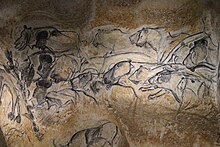
Nevertheless, the definitive advance of these technologies is made by the Aurignacian culture, originating in the Levant (Ahmarian) and Hungary (first full Aurignacian). By 35,000 BC, the Aurignacian culture and its technology had extended through most of Europe. The last Neanderthals seem to have been forced to retreat to the southern half of the Iberian Peninsula. Around 29,000 BC a new technology/culture appeared in the western region of Europe: the Gravettian. This technology/culture has been theorised to have come with migrations of people from the Balkans (see Kozarnika).
Around 16,000 BC, Europe witnessed the appearance of a new culture, known as Magdalenian, possibly rooted in the old Gravettian. This culture soon superseded the Solutrean area and the Gravettian of mainly France, Spain, Germany, Italy, Poland, Portugal and Ukraine. The Hamburg culture prevailed in Northern Europe in the 14th and the 13th millennium BC as the Creswellian (also termed the British Late Magdalenian) did shortly after in the British Isles. Around 12,500 BC, the Würm glaciation ended. Magdalenian culture persisted until c. 10,000 BC, when it quickly evolved into two microlithist cultures: Azilian (Federmesser), in Spain and southern France, and then Sauveterrian, in southern France and Tardenoisian in Central Europe, while in Northern Europe the Lyngby complex succeeded the Hamburg culture with the influence of the Federmesser group as well.
Neolithic and Copper Age[edit]

Evidence of permanent settlement dates from the 8th millennium BC in the Balkans. The Neolithic reached Central Europe in the 6th millennium BC and parts of Northern Europe in the 5th and 4th millenniums BC. The modern indigenous populations of Europe are largely descended from three distinct lineages: Mesolithic hunter-gatherers, a derivative of the Cro-Magnon population, Early European Farmers who migrated from Anatolia during the Neolithic Revolution, and Yamnaya pastoralists who expanded into Europe in the context of the Indo-European expansion.[3] The Indo-European migrations started in Southeast Europe at around c. 4200 BC. through the areas around the Black sea and the Balkan peninsula. In the next 3000 years the Indo-European languages expanded through Europe.

Around this time, in the 5th millennium BC the Varna culture evolved. In 4700 – 4200 BC, the Solnitsata town, believed to be the oldest prehistoric town in Europe, flourished.[4][5]
Ancient Europe[edit]
Bronze Age[edit]
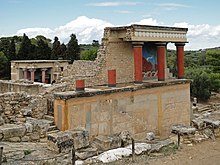
The first well-known literate civilization in Europe was the Minoan civilization that arose on the island of Crete and flourished from approximately the 27th century BC to the 15th century BC.[6]
The Minoans were replaced by the Mycenaean civilization which flourished during the period roughly between 1600 BC, when Helladic culture in mainland Greece was transformed under influences from Minoan Crete, and 1100 BC. The major Mycenaean cities were Mycenae and Tiryns in Argolis, Pylos in Messenia, Athens in Attica, Thebes and Orchomenus in Boeotia, and Iolkos in Thessaly. In Crete, the Mycenaeans occupied Knossos. Mycenaean settlement sites also appeared in Epirus,[7][8] Macedonia,[9][10] on islands in the Aegean Sea, on the coast of Asia Minor, the Levant,[11] Cyprus[12] and Italy.[13][14] Mycenaean artefacts have been found well outside the limits of the Mycenean world.

Quite unlike the Minoans, whose society benefited from trade, the Mycenaeans advanced through conquest. Mycenaean civilization was dominated by a warrior aristocracy. Around 1400 BC, the Mycenaeans extended their control to Crete, the centre of the Minoan civilization, and adopted a form of the Minoan script (called Linear A) to write their early form of Greek in Linear B.
The Mycenaean civilization perished with the collapse of Bronze-Age civilization on the eastern shores of the Mediterranean Sea. The collapse is commonly attributed to the Dorian invasion, although other theories describing natural disasters and climate change have been advanced as well.[citation needed] Whatever the causes, the Mycenaean civilization had definitely disappeared after LH III C, when the sites of Mycenae and Tiryns were again destroyed and lost their importance. This end, during the last years of the 12th century BC, occurred after a slow decline of the Mycenaean civilization, which lasted many years before dying out. The beginning of the 11th century BC opened a new context, that of the protogeometric, the beginning of the geometric period, the Greek Dark Ages of traditional historiography.
The Bronze Age collapse may be seen in the context of a technological history that saw the slow spread of ironworking technology from present-day Bulgaria and Romania in the 13th and the 12th centuries BC.[15]
The Tumulus culture and the following Urnfield culture of central Europe were part of the origin of the Roman and Greek cultures.[16]
Classical Antiquity[edit]

Classical antiquity, also known as the classical era, classical period, classical age, or simply antiquity,[17] is the period of cultural history between the 8th century BC and the 5th century AD comprising the interwoven civilizations of ancient Greece and ancient Rome known together as the Greco-Roman world, centered on the Mediterranean Basin. It is the period during which ancient Greece and ancient Rome flourished and had major influence throughout much of Europe, North Africa, and West Asia.[18][19]
Ancient Greece[edit]
The Hellenic civilisation was a collection of city-states or poleis with different governments and cultures that achieved notable developments in government, philosophy, science, mathematics, politics, sports, theatre and music.
The most powerful city-states were Athens, Sparta, Thebes, Corinth, and Syracuse. Athens was a powerful Hellenic city-state and governed itself with an early form of direct democracy invented by Cleisthenes; the citizens of Athens voted on legislation and executive bills themselves. Athens was the home of Socrates,[20] Plato, and the Platonic Academy.

The Hellenic city-states established colonies on the shores of the Black Sea and the Mediterranean Sea (Asian Minor, Sicily, and Southern Italy in Magna Graecia). By the late 6th century BC, the Greek city states in Asia Minor had been incorporated into the Persian Empire, while the latter had made territorial gains in the Balkans (such as Macedon, Thrace, Paeonia, etc.) and Eastern Europe proper as well. In the course of the 5th century BC, some of the Greek city states attempted to overthrow Persian rule in the Ionian Revolt, which failed. This sparked the first Persian invasion of mainland Greece. At some point during the ensuing Greco-Persian Wars, namely during the Second Persian invasion of Greece, and precisely after the Battle of Thermopylae and the Battle of Artemisium, almost all of Greece to the north of the Isthmus of Corinth had been overrun by the Persians,[21] but the Greek city states reached a decisive victory at the Battle of Plataea. With the end of the Greco-Persian wars, the Persians were eventually forced to withdraw from their territories in Europe. The Greco-Persian Wars and the victory of the Greek city states directly influenced the entire further course of European history and would set its further tone. Some Greek city-states formed the Delian League to continue fighting Persia, but Athens' position as leader of this league led Sparta to form the rival Peloponnesian League. The Peloponnesian Wars ensued, and the Peloponnesian League was victorious. Subsequently, discontent with Spartan hegemony led to the Corinthian War and the defeat of Sparta at the Battle of Leuctra. At the same time at the north ruled the Thracian Odrysian Kingdom between the 5th century BC and the 1st century AD.
Hellenic infighting left Greek city states vulnerable, and Philip II of Macedon united the Greek city states under his control. The son of Philip II, known as Alexander the Great, invaded neighboring Persia, toppled and incorporated its domains, as well as invading Egypt and going as far off as India, increasing contact with people and cultures in these regions that marked the beginning of the Hellenistic period.
After the death of Alexander the Great, his empire split into multiple kingdoms ruled by his generals, the Diadochi. The Diadochi fought against each other in a series of conflicts called the Wars of the Diadochi. In the beginning of the 2nd century BC, only three major kingdoms remained: the Ptolemaic Egypt, the Seleucid Empire and Macedonia. These kingdoms spread Greek culture to regions as far away as Bactria.[22]
Ancient Rome[edit]

Much of Greek learning was assimilated by the nascent Roman state as it expanded outward from Italy, taking advantage of its enemies' inability to unite: the only challenge to Roman ascent came from the Phoenician colony of Carthage, and its defeats in the three Punic Wars marked the start of Roman hegemony. First governed by kings, then as a senatorial republic (the Roman Republic), Rome finally became an empire at the end of the 1st century BC, under Augustus and his authoritarian successors.
The Roman Empire had its centre in the Mediterranean, controlling all the countries on its shores; the northern border was marked by the Rhine and Danube rivers. Under the emperor Trajan (2nd century AD) the empire reached its maximum expansion, controlling approximately 5,900,000 km2 (2,300,000 sq mi) of land surface, including Italia, Gallia, Dalmatia, Aquitania, Britannia, Baetica, Hispania, Thrace, Macedonia, Greece, Moesia, Dacia, Pannonia, Egypt, Asia Minor, Cappadocia, Armenia, Caucasus, North Africa, Levant and parts of Mesopotamia. Pax Romana, a period of peace, civilisation and an efficient centralised government in the subject territories ended in the 3rd century, when a series of civil wars undermined Rome's economic and social strength.

In the 4th century, the emperors Diocletian and Constantine were able to slow down the process of decline by splitting the empire into a Western part with a capital in Rome and an Eastern part with the capital in Byzantium, or Constantinople (now Istanbul). Constantinople is generally considered to be the center of "Eastern Orthodox civilization".[23][24] Whereas Diocletian severely persecuted Christianity, Constantine declared an official end to state-sponsored persecution of Christians in 313 with the Edict of Milan, thus setting the stage for the Church to become the state church of the Roman Empire in about 380.
The Roman Empire had been repeatedly attacked by invading armies from Northern Europe and in 476, Rome finally fell. Romulus Augustus, the last emperor of the Western Roman Empire, surrendered to the Germanic King Odoacer.
Late Antiquity and Migration Period[edit]

When Emperor Constantine had reconquered Rome under the banner of the cross in 312, he soon afterwards issued the Edict of Milan in 313 (preceded by the Edict of Serdica in 311), declaring the legality of Christianity in the Roman Empire. In addition, Constantine officially shifted the capital of the Roman Empire from Rome to the Greek town of Byzantium, which he renamed Nova Roma – it was later named Constantinople ("City of Constantine").
Theodosius I, who had made Christianity the official religion of the Roman Empire, would be the last emperor to preside over a united Roman Empire, until his death in 395. The empire was split into two halves: the Western Roman Empire centred in Ravenna, and the Eastern Roman Empire (later to be referred to as the Byzantine Empire) centred in Constantinople. The Roman Empire was repeatedly attacked by Hunnic, Germanic, Slavic and other "barbarian" tribes (see: Migration Period), and in 476 finally the Western part fell to the Heruli chieftain Odoacer.
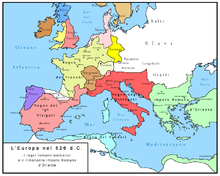
Roman authority in the Western part of the empire had collapsed, and a power vacuum left in the wake of this collapse; the central organization, institutions, laws and power of Rome had broken down, resulting in many areas being open to invasion by migrating tribes. Over time, feudalism and manorialism arose, providing for division of land and labour, as well as a broad if uneven hierarchy of law and protection. These localised hierarchies were based on the bond of common people to the land on which they worked, and to a lord, who would provide and administer both local law to settle disputes among the peasants, as well as protection from outside invaders.
The western provinces soon were to be dominated by three great powers: first, the Franks (Merovingian dynasty) in Francia 481–843 AD, which covered much of present France and Germany; second, the Visigothic kingdom 418–711 AD in the Iberian Peninsula (modern Spain); and third, the Ostrogothic kingdom 493–553 AD in Italy and parts of the western Balkans. The Ostrogoths were later replaced by the Kingdom of the Lombards 568–774 AD. Although these powers covered large territories, they did not have the great resources and bureaucracy of the Roman empire to control regions and localities; more power and responsibilities were left to local lords. On the other hand, it also meant more freedom, particularly in more remote areas.
In Italy, Theodoric the Great began the cultural romanisation of the new world he had constructed. He made Ravenna a centre of Romano-Greek culture of art and his court fostered a flowering of literature and philosophy in Latin. In Iberia, King Chindasuinth created the Visigothic Code. [25]
In the Eastern part the dominant state was the remaining Eastern Roman Empire.
In the feudal system, new princes and kings arose, the most powerful of which was arguably the Frankish ruler Charlemagne. In 800, Charlemagne, reinforced by his massive territorial conquests, was crowned Emperor of the Romans by Pope Leo III, solidifying his power in western Europe. Charlemagne's reign marked the beginning of a new Germanic Roman Empire in the west, the Holy Roman Empire. Outside his borders, new forces were gathering. The Kievan Rus' were marking out their territory, a Great Moravia was growing, while the Angles and the Saxons were securing their borders.
For the duration of the 6th century, the Eastern Roman Empire was embroiled in a series of deadly conflicts, first with the Persian Sassanid Empire (see Roman–Persian Wars), followed by the onslaught of the arising Islamic Caliphate (Rashidun and Umayyad). By 650, the provinces of Egypt, Palestine and Syria were lost to the Muslim forces, followed by Hispania and southern Italy in the 7th and 8th centuries (see Muslim conquests). The Arab invasion from the east was stopped after the intervention of the Bulgarian Empire (see Han Tervel).
Post-classical and Medieval Europe[edit]
The Middle Ages are commonly dated from the fall of the Western Roman Empire (or by some scholars, before that) in the 5th century to the beginning of the early modern period in the 16th century marked by the rise of nation states, the division of Western Christianity in the Reformation, the rise of humanism in the Italian Renaissance, and the beginnings of European overseas expansion which allowed for the Columbian Exchange.[26][27]
Byzantium[edit]

Many consider Emperor Constantine I (reigned 306–337) to be the first "Byzantine emperor". It was he who moved the imperial capital in 324 from Nicomedia to Byzantium, which re-founded as Constantinople, or Nova Roma ("New Rome").[28] The city of Rome itself had not served as the capital since the reign of Diocletian (284–305). Some date the beginnings of the Empire to the reign of Theodosius I (379–395) and Christianity's official supplanting of the pagan Roman religion, or following his death in 395, when the empire was split into two parts, with capitals in Rome and Constantinople. Others place it yet later in 476, when Romulus Augustulus, traditionally considered the last western emperor, was deposed, thus leaving sole imperial authority with the emperor in the Greek East. Others point to the reorganisation of the empire in the time of Heraclius (c. 620) when Latin titles and usages were officially replaced with Greek versions. In any case, the changeover was gradual and by 330, when Constantine inaugurated his new capital, the process of hellenization and increasing Christianisation was already under way. The Empire is generally considered to have ended after the fall of Constantinople to the Ottoman Turks in 1453. The Plague of Justinian was a pandemic that afflicted the Byzantine Empire, including its capital Constantinople, in the years 541–542. It is estimated that the Plague of Justinian killed as many as 100 million people.[29][30] It caused Europe's population to drop by around 50% between 541 and 700.[31] It also may have contributed to the success of the Muslim conquests.[32][33] During most of its existence, the Byzantine Empire was one of the most powerful economic, cultural, and military forces in Europe, and Constantinople was one of the largest and wealthiest cities in Europe.[34]
Early Middle Ages[edit]
The Early Middle Ages span roughly five centuries from 500 to 1000.[35]
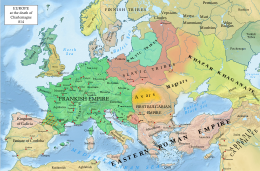
In the East and Southeast of Europe new dominant states formed: the Avar Khaganate (567–after 822), Old Great Bulgaria (632–668), the Khazar Khaganate (c. 650–969) and Danube Bulgaria (founded by Asparuh in 680) were constantly rivaling the hegemony of the Byzantine Empire.
From the 7th century Byzantine history was greatly affected by the rise of Islam and the Caliphates. Muslim Arabs first invaded historically Roman territory under Abū Bakr, first Caliph of the Rashidun Caliphate, who entered Roman Syria and Roman Mesopotamia. As the Byzantines and neighboring Sasanids were severely weakened by the time, amongst the most important reason(s) being the protracted, centuries-lasting and frequent Byzantine–Sasanian wars, which included the climactic Byzantine–Sasanian War of 602–628, under Umar, the second Caliph, the Muslims entirely toppled the Sasanid Persian Empire, and decisively conquered Syria and Mesopotamia, as well as Roman Palestine, Roman Egypt, and parts of Asia Minor and Roman North Africa. In the mid 7th century AD, following the Muslim conquest of Persia, Islam penetrated into the Caucasus region, of which parts would later permanently become part of Russia.[36] This trend, which included the conquests by the invading Muslim forces and by that the spread of Islam as well continued under Umar's successors and under the Umayyad Caliphate, which conquered the rest of Mediterranean North Africa and most of the Iberian Peninsula. Over the next centuries Muslim forces were able to take further European territory, including Cyprus, Malta, Crete, and Sicily and parts of southern Italy.[37]
The Muslim conquest of Hispania began when the Moors invaded the Christian Visigothic kingdom of Hispania in 711, under the Berber general Tariq ibn Ziyad. They landed at Gibraltar on 30 April and worked their way northward. Tariq's forces were joined the next year by those of his Arab superior, Musa ibn Nusair. During the eight-year campaign most of the Iberian Peninsula was brought under Muslim rule – save for small areas in the northwest (Asturias) and largely Basque regions in the Pyrenees. In 711, Visigothic Hispania was weakened because it was immersed in a serious internal crisis caused by a war of succession to the throne. The Muslims took advantage of the crisis within the Hispano-Visigothic society to carry out their conquests. This territory, under the Arab name Al-Andalus, became part of the expanding Umayyad empire.
The second siege of Constantinople (717) ended unsuccessfully after the intervention of Tervel of Bulgaria and weakened the Umayyad dynasty and reduced their prestige. In 722 Don Pelayo formed an army of 300 Astur soldiers, to confront Munuza's Muslim troops. In the battle of Covadonga, the Astures defeated the Arab-Moors, who decided to retire. The Christian victory marked the beginning of the Reconquista and the establishment of the Kingdom of Asturias, whose first sovereign was Don Pelayo. The conquerors intended to continue their expansion in Europe and move northeast across the Pyrenees, but were defeated by the Frankish leader Charles Martel at the Battle of Poitiers in 732. The Umayyads were overthrown in 750 by the 'Abbāsids,[38] and, in 756, the Umayyads established an independent emirate in the Iberian Peninsula.[39]
Feudal Christendom[edit]

The Holy Roman Empire emerged around 800, as Charlemagne, King of the Franks and part of the Carolingian dynasty, was crowned by the pope as emperor. His empire based in modern France, the Low Countries and Germany expanded into modern Hungary, Italy, Bohemia, Lower Saxony and Spain. He and his father received substantial help from an alliance with the Pope, who wanted help against the Lombards.[40] His death marked the beginning of the end of the dynasty, which collapsed entirely by 888. The fragmentation of power led to semi-autonomy in the region, and has been defined as a critical starting point for the formation of states in Europe.[41]
To the east, Bulgaria was established in 681 and became the first Slavic country.[citation needed] The powerful Bulgarian Empire was the main rival of Byzantium for control of the Balkans for centuries and from the 9th century became the cultural centre of Slavic Europe. The Empire created the Cyrillic script during the 9th century AD, at the Preslav Literary School, and experienced the Golden Age of Bulgarian cultural prosperity during the reign of emperor Simeon I the Great (893–927). Two states, Great Moravia and Kievan Rus', emerged among the Slavic peoples respectively in the 9th century. In the late 9th and 10th centuries, northern and western Europe felt the burgeoning power and influence of the Vikings who raided, traded, conquered and settled swiftly and efficiently with their advanced seagoing vessels such as the longships. The Vikings had left a cultural influence on the Anglo-Saxons and Franks as well as the Scots.[42] The Hungarians pillaged mainland Europe, the Pechenegs raided Bulgaria, Rus States and the Arab states. In the 10th century independent kingdoms were established in Central Europe including Poland and the newly settled Kingdom of Hungary. The Kingdom of Croatia also appeared in the Balkans. The subsequent period, ending around 1000, saw the further growth of feudalism, which weakened the Holy Roman Empire.
In eastern Europe, Volga Bulgaria became an Islamic state in 921, after Almış I converted to Islam under the missionary efforts of Ahmad ibn Fadlan.[43]
Slavery in the early medieval period had mostly died out in western Europe by about the year 1000 AD, replaced by serfdom. It lingered longer in England and in peripheral areas linked to the Muslim world, where slavery continued to flourish. Church rules suppressed slavery of Christians. Most historians argue the transition was quite abrupt around 1000, but some see a gradual transition from about 300 to 1000.[44]
High Middle Ages[edit]

In 1054, the East–West Schism occurred between the two remaining Christian seats in Rome and Constantinople (modern Istanbul).
The High Middle Ages of the 11th, 12th, and 13th centuries show a rapidly increasing population of Europe, which caused great social and political change from the preceding era. By 1250, the robust population increase greatly benefited the economy, reaching levels it would not see again in some areas until the 19th century.[45]
From about the year 1000 onwards, Western Europe saw the last of the barbarian invasions and became more politically organized. The Vikings had settled in Britain, Ireland, France and elsewhere, whilst Norse Christian kingdoms were developing in their Scandinavian homelands. The Magyars had ceased their expansion in the 10th century, and by the year 1000, the Roman Catholic Apostolic Kingdom of Hungary was recognised in central Europe. With the brief exception of the Mongol invasions, major barbarian incursions ceased.
Bulgarian sovereignty was re-established with the anti-Byzantine uprising of the Bulgarians and Vlachs in 1185. The crusaders invaded the Byzantine Empire, captured Constantinople in 1204 and established their Latin Empire. Kaloyan of Bulgaria defeated Baldwin I, Latin Emperor of Constantinople, in the Battle of Adrianople on 14 April 1205. The reign of Ivan Asen II of Bulgaria led to maximum territorial expansion and that of Ivan Alexander of Bulgaria to a Second Golden Age of Bulgarian culture. The Byzantine Empire was fully re-established in 1261.
In the 11th century, populations north of the Alps began to settle new lands. Vast forests and marshes of Europe were cleared and cultivated. At the same time settlements moved beyond the traditional boundaries of the Frankish Empire to new frontiers in Europe, beyond the Elbe river, tripling the size of Germany in the process. Crusaders founded European colonies in the Levant, the majority of the Iberian Peninsula was conquered from the Muslims, and the Normans colonised southern Italy, all part of the major population increase and resettlement pattern.
The High Middle Ages produced many different forms of intellectual, spiritual and artistic works. The most famous are the great cathedrals as expressions of Gothic architecture, which evolved from Romanesque architecture. This age saw the rise of modern nation-states in Western Europe and the ascent of the famous Italian city-states, such as Florence and Venice. The influential popes of the Catholic Church called volunteer armies from across Europe to a series of Crusades against the Seljuq Turks, who occupied the Holy Land. The rediscovery of the works of Aristotle led Thomas Aquinas and other thinkers to develop the philosophy of Scholasticism.
Holy wars[edit]

After the East–West Schism, Western Christianity was adopted by the newly created kingdoms of Central Europe: Poland, Hungary and Bohemia. The Roman Catholic Church developed as a major power, leading to conflicts between the Pope and emperor. The geographic reach of the Roman Catholic Church expanded enormously due to the conversions of pagan kings (Scandinavia, Lithuania, Poland, Hungary), the Christian Reconquista of Al-Andalus, and the Crusades. Most of Europe was Roman Catholic in the 15th century.
Early signs of the rebirth of civilization in western Europe began to appear in the 11th century as trade started again in Italy, leading to the economic and cultural growth of independent city-states such as Venice and Florence; at the same time, nation-states began to take form in places such as France, England, Spain, and Portugal, although the process of their formation (usually marked by rivalry between the monarchy, the aristocratic feudal lords and the church) actually took several centuries. These new nation-states began writing in their own cultural vernaculars, instead of the traditional Latin. Notable figures of this movement would include Dante Alighieri and Christine de Pizan. The Holy Roman Empire, essentially based in Germany and Italy, further fragmented into a myriad of feudal principalities or small city states, whose subjection to the emperor was only formal.
The 14th century, when the Mongol Empire came to power, is often called the Age of the Mongols. Mongol armies expanded westward under the command of Batu Khan. Their western conquests included almost all of Kievan Rus' (save Novgorod, which became a vassal),[46] and the Kipchak-Cuman Confederation. Bulgaria, Hungary, and Poland managed to remain sovereign states. Mongolian records indicate that Batu Khan was planning a complete conquest of the remaining European powers, beginning with a winter attack on Austria, Italy and Germany, when he was recalled to Mongolia upon the death of Great Khan Ögedei. Most historians believe only his death prevented the complete conquest of Europe.[citation needed] The areas of Eastern Europe and most of Central Asia that were under direct Mongol rule became known as the Golden Horde. Under Uzbeg Khan, Islam became the official religion of the region in the early 14th century.[47] The invading Mongols, together with their mostly Turkic subjects, were known as Tatars. In Russia, the Tatars ruled the various states of the Rus' through vassalage for over 300 years.

In the Northern Europe, Konrad of Masovia gave Chełmno to the Teutonic Knights in 1226 as a base for a Crusade against the Old Prussians and Grand Duchy of Lithuania. The Livonian Brothers of the Sword were defeated by the Lithuanians, so in 1237 Gregory IX merged the remainder of the order into the Teutonic Order as the Livonian Order. By the middle of the century, the Teutonic Knights completed their conquest of the Prussians before converting the Lithuanians in the subsequent decades. The order also came into conflict with the Eastern Orthodox Church of the Pskov and Novgorod Republics. In 1240 the Orthodox Novgorod army defeated the Catholic Swedes in the Battle of the Neva, and, two years later, they defeated the Livonian Order in the Battle on the Ice. The Union of Krewo in 1386, bringing two major changes in the history of the Grand Duchy of Lithuania: conversion to Catholicism and establishment of a dynastic union between the Grand Duchy of Lithuania and the Crown of the Kingdom of Poland marked both the greatest territorial expansion of the Grand Duchy and the defeat of the Teutonic Knights in the Battle of Grunwald in 1410.
Late Middle Ages[edit]

The Late Middle Ages spanned around the 14th and late 15th centuries.[48] Around 1300, centuries of European prosperity and growth came to a halt. A series of famines and plagues, such as the Great Famine of 1315–1317 and the Black Death, killed people in a matter of days, reducing the population of some areas by half as many survivors fled. Kishlansky reports:
- The Black Death touched every aspect of life, hastening a process of social, economic, and cultural transformation already underway.... Fields were abandoned, workplaces stood idle, international trade was suspended. Traditional bonds of kinship, village, and even religion were broken amid the horrors of death, flight, and failed expectations. "People cared no more for dead men than we care for dead goats," wrote one survivor.[49]
Depopulation caused labor to become scarcer; the survivors were better paid and peasants could drop some of the burdens of feudalism. There was also social unrest; France and England experienced serious peasant risings including the Jacquerie and the Peasants' Revolt. The unity of the Catholic Church was shattered by the Great Schism. Collectively these events have been called the Crisis of the Late Middle Ages.[50]
Beginning in the 14th century, the Baltic Sea became one of the most important trade routes. The Hanseatic League, an alliance of trading cities, facilitated the absorption of vast areas of Poland, Lithuania, and Livonia into trade with other European countries. This fed the growth of powerful states in this part of Europe including Poland–Lithuania, Hungary, Bohemia, and Muscovy later on. The conventional end of the Middle Ages is usually associated with the fall of the city of Constantinople and of the Byzantine Empire to the Ottoman Turks in 1453. The Turks made the city the capital of their Ottoman Empire, which lasted until 1922 and included Egypt, Syria, and most of the Balkans. The Ottoman wars in Europe marked an essential part of the history of the continent.
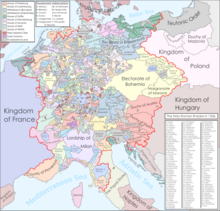
A key 15th-century development was the advent of the movable type of printing press circa 1439 in Mainz,[51] building upon the impetus provided by the prior introduction of paper from China via the Arabs in the High Middle Ages.[52] The adoption of the technology across the continent at dazzling speed for the remaining part of the 15th century would usher a revolution and by 1500 over 200 cities in Europe had presses that printed between 8 and 20 million books.[51]
Early modern Europe[edit]

The Early Modern period spans the centuries between the Middle Ages and the Industrial Revolution, roughly from 1500 to 1800, or from the discovery of the New World in 1492 to the French Revolution in 1789. The period is characterised by the rise in importance of science and increasingly rapid technological progress, secularised civic politics, and the nation state. Capitalist economies began their rise, and the early modern period also saw the rise and dominance of the economic theory of mercantilism. As such, the early modern period represents the decline and eventual disappearance, in much of the European sphere, of feudalism, serfdom and the power of the Catholic Church. The period includes the Renaissance, the Scientific Revolution, the Protestant Reformation, the disastrous Thirty Years' War, the European colonisation of the Americas and the European witch-hunts.
Renaissance[edit]
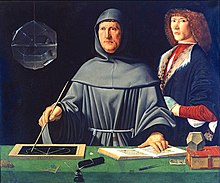
Despite these crises, the 14th century was also a time of great progress within the arts and sciences. A renewed interest in ancient Greek and Roman led to the Italian Renaissance, a cultural movement that profoundly affected European intellectual life in the early modern period. Beginning in Italy, and spreading to the north, west and middle Europe during a cultural lag of some two and a half centuries, its influence affected literature, philosophy, art, politics, science, history, religion, and other aspects of intellectual inquiry. The Humanists saw their repossession of a great past as a Renaissance – a rebirth of civilization itself.[53] Important political precedents were also set in this period. Niccolò Machiavelli's political writing in The Prince influenced later absolutism and realpolitik. Also important were the many patrons who ruled states and used the artistry of the Renaissance as a sign of their power.
The Scientific Revolution took place in Europe starting towards the second half of the Renaissance period, with the 1543 Nicolaus Copernicus publication De revolutionibus orbium coelestium (On the Revolutions of the Heavenly Spheres) often cited as its beginning.
Exploration and trade[edit]

Toward the end of the period, an era of discovery began. The growth of the Ottoman Empire, culminating in the fall of Constantinople in 1453, cut off trading possibilities with the east. Western Europe was forced to discover new trading routes, as happened with Columbus' travel to the Americas in 1492, and Vasco da Gama's circumnavigation of India and Africa in 1498.
The numerous wars did not prevent European states from exploring and conquering wide portions of the world, from Africa to Asia and the newly discovered Americas. In the 15th century, Portugal led the way in geographical exploration along the coast of Africa in search of a maritime route to India, followed by Spain near the close of the 15th century, dividing their exploration of the world according to the Treaty of Tordesillas in 1494.[54] They were the first states to set up colonies in America and European trading posts (factories) along the shores of Africa and Asia, establishing the first direct European diplomatic contacts with Southeast Asian states in 1511, China in 1513 and Japan in 1542. In 1552, Russian tsar Ivan the Terrible conquered two major Tatar khanates, the Khanate of Kazan and the Astrakhan Khanate. The Yermak's voyage of 1580 led to the annexation of the Tatar Siberian Khanate into Russia, and the Russians would soon after conquer the rest of Siberia, steadily expanding to the east and south over the next centuries. Oceanic explorations soon followed by France, England and the Netherlands, who explored the Portuguese and Spanish trade routes into the Pacific Ocean, reaching Australia in 1606[55] and New Zealand in 1642.
Reformation[edit]
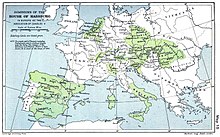
With the development of the printing press, new ideas spread throughout Europe and challenged traditional doctrines in science and theology. Simultaneously, the Reformation under German Martin Luther questioned Papal authority. The most common dating of the Reformation begins in 1517, when Luther published The Ninety-Five Theses, and concludes in 1648 with the Treaty of Westphalia that ended years of European religious wars.[56]
During this period corruption in the Catholic Church led to a sharp backlash in the Protestant Reformation. It gained many followers especially among princes and kings seeking a stronger state by ending the influence of the Catholic Church. Figures other than Martin Luther began to emerge as well like John Calvin whose Calvinism had influence in many countries and King Henry VIII of England who broke away from the Catholic Church in England and set up the Anglican Church. These religious divisions brought on a wave of wars inspired and driven by religion but also by the ambitious monarchs in Western Europe who were becoming more centralized and powerful.
The Protestant Reformation also led to a strong reform movement in the Catholic Church called the Counter-Reformation, which aimed to reduce corruption as well as to improve and strengthen Catholic dogma. Two important groups in the Catholic Church who emerged from this movement were the Jesuits, who helped keep Spain, Portugal, Poland, and other European countries within the Catholic fold, and the Oratorians of Saint Philip Neri, who ministered to the faithful in Rome, restoring their confidence in the Church of Jesus Christ that subsisted substantially in the Church of Rome. Still, the Catholic Church was somewhat weakened by the Reformation, portions of Europe were no longer under its sway and kings in the remaining Catholic countries began to take control of the church institutions within their kingdoms.
Unlike many European countries, the Polish–Lithuanian Commonwealth and Hungary were more tolerant. While still enforcing the predominance of Catholicism, they continued to allow the large religious minorities to maintain their faiths, traditions and customs. The Polish–Lithuanian Commonwealth became divided among Catholics, Protestants, Orthodox, Jews and a small Muslim population.
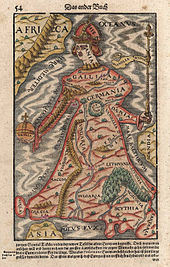
Another development was the idea of 'European superiority'. There was a movement by some such as Montaigne that regarded the non-Europeans as a better, more natural and primitive people. Post services were founded all over Europe, which allowed a humanistic interconnected network of intellectuals across Europe, despite religious divisions. However, the Roman Catholic Church banned many leading scientific works; this led to an intellectual advantage for Protestant countries, where the banning of books was regionally organised. Francis Bacon and other advocates of science tried to create unity in Europe by focusing on the unity in nature.1 In the 15th century, at the end of the Middle Ages, powerful sovereign states were appearing, built by the New Monarchs who were centralising power in France, England, and Spain. On the other hand, the Parliament in the Polish–Lithuanian Commonwealth grew in power, taking legislative rights from the Polish king. The new state power was contested by parliaments in other countries especially England. New kinds of states emerged which were co-operation agreements among territorial rulers, cities, farmer republics and knights.

Mercantilism and colonial expansion[edit]

The Iberian kingdoms were able to dominate colonial activity in the 16th century. The Portuguese forged the first global empire in the 15th and 16th century, whilst during the 16th century and the first half of the 17th century, the crown of Castile (and the overarching Hispanic Monarchy, including Portugal from 1580 to 1640) became the most powerful empire in the world. Spanish dominance in America was increasingly challenged by British, French, Dutch and Swedish colonial efforts of the 17th and 18th centuries. New forms of trade and expanding horizons made new forms of government, law and economics necessary.
Colonial expansion continued in the following centuries (with some setbacks, such as successful wars of independence in the British American colonies and then later Haiti, Mexico, Argentina, Brazil, and others amid European turmoil of the Napoleonic Wars). Spain had control of a large part of North America, all of Central America and a great part of South America, the Caribbean and the Philippines; Britain took the whole of Australia and New Zealand, most of India, and large parts of Africa and North America; France held parts of Canada and India (nearly all of which was lost to Britain in 1763), Indochina, large parts of Africa and the Caribbean islands; the Netherlands gained the East Indies (now Indonesia) and islands in the Caribbean; Portugal obtained Brazil and several territories in Africa and Asia; and later, powers such as Germany, Belgium, Italy and Russia acquired further colonies.[citation needed]
This expansion helped the economy of the countries owning them. Trade flourished, because of the minor stability of the empires. By the late 16th century, American silver accounted for one-fifth of Spain's total budget.[57][58] The French colony of Saint-Domingue was one of richest European colonies in the 18th century, operating on a plantation economy fueled by slave labor. During the period of French rule, cash crops produced in Saint-Domingue comprised thirty percent of total French trade while its sugar exports represented forty percent of the Atlantic market.[59][60]
Crisis of the 17th century[edit]

The 17th century was an era of crisis.[61][62] Many historians have rejected the idea, while others promote it as an invaluable insight into the warfare, politics, economics,[63] and even art.[64] The Thirty Years' War (1618–1648) focused attention on the massive horrors that wars could bring to entire populations.[65] The 1640s in particular saw more state breakdowns around the world than any previous or subsequent period.[61][62] The Polish–Lithuanian Commonwealth, the largest state in Europe, temporarily disappeared. In addition, there were secessions and upheavals in several parts of the Spanish empire, the world's first global empire. In Britain the entire Stuart monarchy (England, Scotland, Ireland, and its North American colonies) rebelled. Political insurgency and a spate of popular revolts seldom equalled shook the foundations of most states in Europe and Asia. More wars took place around the world in the mid-17th century than in almost any other period of recorded history. Across the Northern Hemisphere, the mid-17th century experienced almost unprecedented death rates.
Age of absolutism[edit]
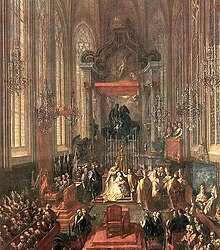
The "absolute" rule of powerful monarchs such as Louis XIV (ruled France 1643–1715),[66] Peter the Great (ruled Russia 1682–1725),[67] Maria Theresa (ruled Habsburg lands 1740–1780) and Frederick the Great (ruled Prussia 1740–86),[68] produced powerful centralized states, with strong armies and powerful bureaucracies, all under the control of the king.[69]
Throughout the early part of this period, capitalism (through mercantilism) was replacing feudalism as the principal form of economic organisation, at least in the western half of Europe. The expanding colonial frontiers resulted in a Commercial Revolution. The period is noted for the rise of modern science and the application of its findings to technological improvements, which animated the Industrial Revolution after 1750.
The Reformation had profound effects on the unity of Europe. Not only were nations divided one from another by their religious orientation, but some states were torn apart internally by religious strife, avidly fostered by their external enemies. France suffered this fate in the 16th century in the series of conflicts known as the French Wars of Religion, which ended in the triumph of the Bourbon Dynasty. England settled down under Elizabeth I to a moderate Anglicanism. Much of modern-day Germany was made up of numerous small sovereign states under the theoretical framework of the Holy Roman Empire, which was further divided along internally drawn sectarian lines. The Polish–Lithuanian Commonwealth is notable in this time for its religious indifference and general immunity to European religious strife.
Thirty Years' War 1618–1648[edit]
The Thirty Years' War was fought between 1618 and 1648, across Germany and neighbouring areas, and involved most of the major European powers except England and Russia,[70] involving Catholics versus Protestants for the most part. The major impact of the war was the devastation of entire regions scavenged bare by the foraging armies. Episodes of widespread famine and disease, and the breakup of family life, devastated the population of the German states and, to a lesser extent, the Low Countries, the Crown of Bohemia and northern parts of Italy, while bankrupting many of the regional powers involved. Between one-fourth and one-third of the German population perished from direct military causes or from disease and starvation, as well as postponed births.[71]
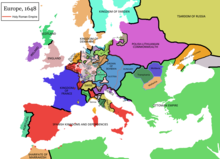
After the Peace of Westphalia, which ended the war in favour of nations deciding their own religious allegiance, absolutism became the norm of the continent, while parts of Europe experimented with constitutions foreshadowed by the English Civil War and particularly the Glorious Revolution. European military conflict did not cease, but had less disruptive effects on the lives of Europeans. In the advanced northwest, the Enlightenment gave a philosophical underpinning to the new outlook, and the continued spread of literacy, made possible by the printing press, created new secular forces in thought.
From the Union of Krewo, central and eastern Europe was dominated by Kingdom of Poland and Grand Duchy of Lithuania. In the 16th and 17th centuries Central and Eastern Europe was an arena of conflict for domination of the continent between Sweden, the Polish–Lithuanian Commonwealth (involved in series of wars, like Khmelnytsky uprising, Russo-Polish War, the Deluge, etc.) and the Ottoman Empire. This period saw a gradual decline of these three powers which were eventually replaced by new enlightened absolutist monarchies: Russia, Prussia and Austria (the Habsburg monarchy). By the turn of the 19th century they had become new powers, having divided Poland between themselves, with Sweden and Turkey having experienced substantial territorial losses to Russia and Austria respectively as well as pauperisation.

War of the Spanish Succession[edit]
The War of the Spanish Succession (1701–1715) was a major war with France opposed by a coalition of England, the Netherlands, the Habsburg monarchy, and Prussia. Duke of Marlborough commanded the English and Dutch victory at the Battle of Blenheim in 1704. The main issue was whether France under King Louis XIV would take control of Spain's very extensive possessions and thereby become by far the dominant power, or be forced to share power with other major nations. After initial allied successes, the long war produced a military stalemate and ended with the Treaty of Utrecht, which was based on a balance of power in Europe. Historian Russell Weigley argues that the many wars almost never accomplished more than they cost.[72] British historian G. M. Trevelyan argues:
- That Treaty [of Utrecht], which ushered in the stable and characteristic period of Eighteenth-Century civilization, marked the end of danger to Europe from the old French monarchy, and it marked a change of no less significance to the world at large – the maritime, commercial and financial supremacy of Great Britain.[73]
Prussia[edit]
Frederick the Great, king of Prussia 1740–86, modernized the Prussian army, introduced new tactical and strategic concepts, fought mostly successful wars (Silesian Wars, Seven Years' War) and doubled the size of Prussia.[74][75]
Russia[edit]

Russia fought numerous wars to achieve rapid expansion toward the east – i.e. Siberia, Far East, south, to the Black Sea, and south-east and to central Asia. Russia boasted a large and powerful army, a very large and complex internal bureaucracy, and a splendid court that rivaled Paris and London. However the government was living far beyond its means and seized Church lands, leaving organized religion in a weak condition. Throughout the 18th century Russia remained "a poor, backward, overwhelmingly agricultural, and illiterate country."[76]
Enlightenment[edit]
The Enlightenment was a powerful, widespread cultural movement of intellectuals beginning in late 17th-century Europe emphasizing the power of reason rather than tradition; it was especially favourable to science (especially Isaac Newton's physics) and hostile to religious orthodoxy (especially of the Catholic Church).[77] It sought to analyze and reform society using reason, to challenge ideas grounded in tradition and faith, and to advance knowledge through the scientific method. It promoted scientific thought, skepticism, and intellectual interchange.[78] The Enlightenment was a revolution in human thought. This new way of thinking was that rational thought begins with clearly stated principles, uses correct logic to arrive at conclusions, tests the conclusions against evidence, and then revises the principles in light of the evidence.[78]
Enlightenment thinkers opposed superstition. Some Enlightenment thinkers collaborated with Enlightened despots, absolutist rulers who attempted to forcibly impose some of the new ideas about government into practice. The ideas of the Enlightenment exerted significant influence on the culture, politics, and governments of Europe.[79]
Originating in the 17th century, it was sparked by philosophers Francis Bacon, Baruch Spinoza, John Locke, Pierre Bayle, Voltaire, Francis Hutcheson, David Hume and physicist Isaac Newton.[80] Ruling princes often endorsed and fostered these figures and even attempted to apply their ideas of government in what was known as enlightened absolutism. The Scientific Revolution is closely tied to the Enlightenment, as its discoveries overturned many traditional concepts and introduced new perspectives on nature and man's place within it. The Enlightenment flourished until about 1790–1800, at which point the Enlightenment, with its emphasis on reason, gave way to Romanticism, which placed a new emphasis on emotion; a Counter-Enlightenment began to increase in prominence.
In France, Enlightenment was based in the salons and culminated in the great Encyclopédie (1751–72). These new intellectual strains would spread to urban centres across Europe, notably England, Scotland, the German states, the Netherlands, Poland, Russia, Italy, Austria, and Spain, as well as Britain's American colonies. The political ideals of the Enlightenment influenced the American Declaration of Independence, the United States Bill of Rights, the French Declaration of the Rights of Man and of the Citizen, and the Polish–Lithuanian Constitution of 3 May 1791.[81]
Norman Davies has argued that Freemasonry was a powerful force on behalf of Liberalism and Enlightenment ideas in Europe, from about 1700 to the 20th century. It expanded rapidly during the Age of Enlightenment, reaching practically every country in Europe.[82] The great enemy of Freemasonry was the Roman Catholic Church, so that in countries with a large Catholic element, such as France, Italy, Austria, Spain and Mexico, much of the ferocity of the political battles involve the confrontation between supporters of the Church versus active Masons.[83][84] 20th-century totalitarian and revolutionary movements, especially the Fascists and Communists, crushed the Freemasons.[85]
From revolution to imperialism (1789–1914)[edit]
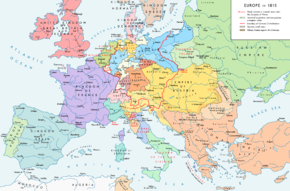
The "long 19th century", from 1789 to 1914 saw the drastic social, political and economic changes initiated by the Industrial Revolution, the French Revolution and the Napoleonic Wars. Following the reorganisation of the political map of Europe at the Congress of Vienna in 1815, Europe experienced the rise of Nationalism, the rise of the Russian Empire and the peak of the British Empire, as well as the decline of the Ottoman Empire. Finally, the rise of the German Empire and the Austro-Hungarian Empire initiated the course of events that culminated in the outbreak of the First World War in 1914.
Industrial Revolution[edit]
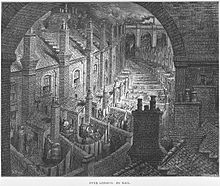
The Industrial Revolution saw major changes in agriculture, manufacturing, and transport impacted Britain and subsequently spread to the United States and Western Europe. Technological advancements, most notably the utilization of the steam engine, were major catalysts in the industrialisation process. It started in England and Scotland in the mid-18th century with the mechanisation of the textile industries, the development of iron-making techniques and the increased use of coal as the main fuel. Trade expansion was enabled by the introduction of canals, improved roads and railways. The introduction of steam power (fuelled primarily by coal) and powered machinery (mainly in textile manufacturing) underpinned the dramatic increases in production capacity.[86] The development of all-metal machine tools in the first two decades of the 19th century facilitated the manufacture of more production machines for manufacturing in other industries. The effects spread throughout Western Europe and North America during the 19th century, eventually affecting most of the world.[87]
Era of the French Revolution[edit]
Historians R.R. Palmer and Joel Colton argue:
- In 1789 France fell into revolution, and the world has never since been the same. The French Revolution was by far the most momentous upheaval of the whole revolutionary age. It replaced the "old regime" with "modern society," and at its extreme phase became very radical, so much so that all later revolutionary movements have looked back to it as a predecessor to themselves.... From the 1760s to 1848, the role of France was decisive.[88]
The era of the French Revolution and the subsequent Napoleonic wars was a difficult time for monarchs. Tsar Paul I of Russia was assassinated; King Louis XVI of France was executed, as was his queen Marie Antoinette. Furthermore, kings Charles IV of Spain, Ferdinand VII of Spain and Gustav IV Adolf of Sweden were deposed as were ultimately the Emperor Napoleon and all of the relatives he had installed on various European thrones. King Frederick William III of Prussia and Emperor Francis II of Austria barely clung to their thrones. King George III of Great Britain lost the better part of the First British Empire.[89]
The American Revolution (1775–1783) was the first successful revolt of a colony against a European power. It rejected aristocracy and established a republican form of government that attracted worldwide attention.[90] The French Revolution (1789–1804) was a product of the same democratic forces in the Atlantic World and had an even greater impact.[91] French historian François Aulard says:
- From the social point of view, the Revolution consisted in the suppression of what was called the feudal system, in the emancipation of the individual, in greater division of landed property, the abolition of the privileges of noble birth, the establishment of equality, the simplification of life.... The French Revolution differed from other revolutions in being not merely national, for it aimed at benefiting all humanity."[92]
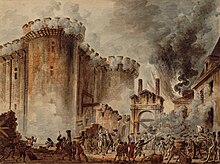
French intervention in the American Revolutionary War had nearly bankrupted the state. After repeated failed attempts at financial reform, King Louis XVI had to convene the Estates-General, a representative body of the country made up of three estates: the clergy, the nobility, and the commoners. The third estate, joined by members of the other two, declared itself to be a National Assembly and created, in July, the National Constituent Assembly. At the same time the people of Paris revolted, famously storming the Bastille prison on 14 July 1789.
At the time the assembly wanted to create a constitutional monarchy, and over the following two years passed various laws including the Declaration of the Rights of Man and of the Citizen, the abolition of feudalism, and a fundamental change in the relationship between France and Rome. At first the king agreed with these changes and enjoyed reasonable popularity with the people. As anti-royalism increased along with threat of foreign invasion, the king tried to flee and join France's enemies. He was captured and on 21 January 1793, having been convicted of treason, he was guillotined.
On 20 September 1792 the National Convention abolished the monarchy and declared France a republic. Due to the emergency of war, the National Convention created the Committee of Public Safety to act as the country's executive. Under Maximilien de Robespierre, the committee initiated the Reign of Terror, during which up to 40,000 people were executed in Paris, mainly nobles and those convicted by the Revolutionary Tribunal, often on the flimsiest of evidence. Internal tensions at Paris drove the Committee towards increasing assertions of radicalism and increasing suspicions. A few months into this phase, more and more prominent revolutionaries were being sent to the guillotine by Robespierre and his faction, for example Madame Roland and Georges Danton. Elsewhere in the country, counter-revolutionary insurrections were brutally suppressed. The regime was overthrown in the coup of 9 Thermidor (27 July 1794) and Robespierre was executed. The regime which followed ended the Terror and relaxed Robespierre's more extreme policies.
Napoleon[edit]
Napoleon Bonaparte was France's most successful general in the Revolutionary wars. In 1799 on 18 Brumaire (9 November) he overthrew the government, replacing it with the Consulate, which he dominated. He gained popularity in France by restoring the Church, keeping taxes low, centralizing power in Paris, and winning glory on the battlefield. In 1804 he crowned himself Emperor. In 1805, Napoleon planned to invade Britain, but a renewed British alliance with Russia and Austria (Third Coalition), forced him to turn his attention towards the continent, while at the same time the French fleet was demolished by the British at the Battle of Trafalgar, ending any plan to invade Britain. On 2 December 1805, Napoleon defeated a numerically superior Austro-Russian army at Austerlitz, forcing Austria's withdrawal from the coalition (see Treaty of Pressburg) and dissolving the Holy Roman Empire. In 1806, a Fourth Coalition was set up. On 14 October Napoleon defeated the Prussians at the Battle of Jena-Auerstedt, marched through Germany and defeated the Russians on 14 June 1807 at Friedland. The Treaties of Tilsit divided Europe between France and Russia and created the Duchy of Warsaw.

On 12 June 1812 Napoleon invaded Russia with a Grande Armée of nearly 700,000 troops. After the measured victories at Smolensk and Borodino Napoleon occupied Moscow, only to find it burned by the retreating Russian army. He was forced to withdraw. On the march back his army was harassed by Cossacks, and suffered disease and starvation. Only 20,000 of his men survived the campaign. By 1813 the tide had begun to turn from Napoleon. Having been defeated by a seven nation army at the Battle of Leipzig in October 1813, he was forced to abdicate after the Six Days' Campaign and the occupation of Paris. Under the Treaty of Fontainebleau he was exiled to the island of Elba. He returned to France on 1 March 1815 (see Hundred Days), raised an army, but was finally defeated by a British and Prussian force at the Battle of Waterloo on 18 June 1815 and exiled to the small British island of Saint Helena.
Impact of the French Revolution[edit]
Roberts finds that the Revolutionary and Napoleonic wars, from 1793 to 1815, caused 4 million deaths (of whom 1 million were civilians); 1.4 million were French.[93]
Outside France the Revolution had a major impact. Its ideas became widespread. Roberts argues that Napoleon was responsible for key ideas of the modern world, so that, "meritocracy, equality before the law, property rights, religious toleration, modern secular education, sound finances, and so on-were protected, consolidated, codified, and geographically extended by Napoleon during his 16 years of power."[94]
Furthermore, the French armies in the 1790s and 1800s directly overthrew feudal remains in much of western Europe. They liberalised property laws, ended seigneurial dues, abolished the guild of merchants and craftsmen to facilitate entrepreneurship, legalised divorce, closed the Jewish ghettos and made Jews equal to everyone else. The Inquisition ended as did the Holy Roman Empire. The power of church courts and religious authority was sharply reduced and equality under the law was proclaimed for all men.[95]
France conquered Belgium and turned it into another province of France. It conquered the Netherlands, and made it a client state. It took control of the German areas on the left bank of the Rhine River and set up a puppet Confederation of the Rhine. It conquered Switzerland and most of Italy, setting up a series of puppet states. The result was glory and an infusion of much needed money from the conquered lands. However the enemies of France, led by Britain, formed a Second Coalition in 1799 (with Britain joined by Russia, the Ottoman Empire and Austria). It scored a series of victories that rolled back French successes, and trapped the French Army in Egypt. Napoleon slipped through the British blockade in October 1799, returning to Paris, where he overthrew the government and made himself the ruler.[96][97]
Napoleon conquered most of Italy in the name of the French Revolution in 1797–99. He split up Austria's holdings and set up a series of new republics, complete with new codes of law and abolition of feudal privileges. Napoleon's Cisalpine Republic was centered on Milan; Genoa became a republic; the Roman Republic was formed as well as the small Ligurian Republic around Genoa. The Neapolitan Republic was formed around Naples, but it lasted only five months. He later formed the Kingdom of Italy, with his brother as King. In addition, France turned the Netherlands into the Batavian Republic, and Switzerland into the Helvetic Republic. All these new countries were satellites of France, and had to pay large subsidies to Paris, as well as provide military support for Napoleon's wars. Their political and administrative systems were modernized, the metric system introduced, and trade barriers reduced. Jewish ghettos were abolished. Belgium and Piedmont became integral parts of France.[98]

Most of the new nations were abolished and returned to prewar owners in 1814. However, Artz emphasizes the benefits the Italians gained from the French Revolution:
- For nearly two decades the Italians had excellent codes of law, a fair system of taxation, a better economic situation, and more religious and intellectual toleration than they had known for centuries.... Everywhere old physical, economic, and intellectual barriers had been thrown down and the Italians had begun to be aware of a common nationality.[99]
Likewise in Switzerland the long-term impact of the French Revolution has been assessed by Martin:
- It proclaimed the equality of citizens before the law, equality of languages, freedom of thought and faith; it created a Swiss citizenship, basis of our modern nationality, and the separation of powers, of which the old regime had no conception; it suppressed internal tariffs and other economic restraints; it unified weights and measures, reformed civil and penal law, authorized mixed marriages (between Catholics and Protestants), suppressed torture and improved justice; it developed education and public works.[100]
The greatest impact came in France itself. In addition to effects similar to those in Italy and Switzerland, France saw the introduction of the principle of legal equality, and the downgrading of the once powerful and rich Catholic Church. Power became centralized in Paris, with its strong bureaucracy and an army supplied by conscripting all young men. French politics were permanently polarized – new names were given, "left" and "right" for the supporters and opponents of the principles of the Revolution.
Religion[edit]
By the 19th century, governments increasingly took over traditional religious roles, paying much more attention to efficiency and uniformity than to religiosity. Secular bodies took control of education away from the churches, abolished taxes and tithes for the support of established religions, and excluded bishops from the upper houses. Secular laws increasingly regulated marriage and divorce, and maintaining birth and death registers became the duty of local officials. Although the numerous religious denominations in the United States founded many colleges and universities, that was almost exclusively a state function across Europe. Imperial powers protected Christian missionaries in African and Asian colonies.[101] In France and other largely Catholic nations, anti-clerical political movements tried to reduce the role of the Catholic Church. Likewise briefly in Germany in the 1870s there was a fierce Kulturkampf (culture war) against Catholics, but the Catholics successfully fought back. The Catholic Church concentrated more power in the papacy and fought against secularism and socialism. It sponsored devotional reforms that gained wide support among the churchgoers.[102]
Nations rising[edit]
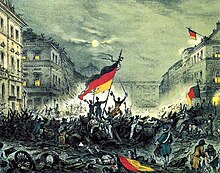
The political development of nationalism and the push for popular sovereignty culminated with the ethnic/national revolutions of Europe. During the 19th century nationalism became one of the most significant political and social forces in history; it is typically listed among the top causes of World War I.[103][104] Most European states had become constitutional monarchies by 1871, and Germany and Italy merged many small city-states to become united nation-states. Germany in particular increasingly dominated the continent in economics and political power. Meanwhile, on a global scale, Great Britain, with its far-flung British Empire, unmatched Royal Navy, and powerful bankers, became the world's first global power. The sun never set on its territories, while an informal empire operated through British financiers, entrepreneurs, traders and engineers who established operations in many countries, and largely dominated Latin America. The British were especially famous for financing and constructing railways around the world.[105]
Napoleon's conquests of the German and Italian states around 1800–1806 played a major role in stimulating nationalism and demand for national unity.[106]
Germany[edit]
In the German states east of Prussia Napoleon abolished many of the old or medieval relics, such as dissolving the Holy Roman Empire in 1806.[107] He imposed rational legal systems and his organization of the Confederation of the Rhine in 1806 promoted a feeling of German nationalism. In the 1860s it was Prussian chancellor Otto von Bismarck who achieved German unification in 1870 after the many smaller states followed Prussia's leadership in wars against Denmark, Austria and France.[108]
Italy[edit]
Italian nationalism emerged in the 19th century and was the driving force for Italian unification or the "Risorgimento". It was the political and intellectual movement that consolidated different states of the Italian Peninsula into the single state of the Kingdom of Italy in 1860. The memory of the Risorgimento is central to both Italian nationalism and Italian historiography.[109]

Serbia[edit]

For centuries the Orthodox Christian Serbs were ruled by the Muslim-controlled Ottoman Empire. The success of the Serbian revolution (1804–1817) against Ottoman rule in 1817 marked the foundation of modern Principality of Serbia. It achieved de facto independence in 1867 and finally gained recognition in the Berlin Congress of 1878. The Serbs developed a larger vision for nationalism in Pan-Slavism and with Russian support sought to pull the other Slavs out of the Austro-Hungarian Empire.[110][111] Austria, with German backing, tried to crush Serbia in 1914 but Russia intervened, thus igniting the First World War in which Austria dissolved into nation states.[112]
In 1918, the region of Vojvodina proclaimed its secession from Austria-Hungary to unite with the pan-Slavic State of Slovenes, Croats and Serbs; the Kingdom of Serbia joined the union on 1 December 1918, and the country was named Kingdom of Serbs, Croats, and Slovenes. It was renamed Yugoslavia, which was never able to tame the multiple nationalities and religions and it flew apart in civil war in the 1990s.
Greece[edit]
The Greek drive for independence from the Ottoman Empire inspired supporters across Christian Europe, especially in Britain. France, Russia and Britain intervened to make this nationalist dream become reality with the Greek War of Independence (1821-1829/1830).[113]
Bulgaria[edit]
Bulgarian modern nationalism emerged under Ottoman rule in the late 18th and early 19th century. An autonomous Bulgarian Exarchate was established in 1870/1872 for the diocese of Bulgaria as well as for those, wherein at least two-thirds of Orthodox Christians were willing to join it. The April Uprising in 1876 indirectly resulted in the re-establishment of Bulgaria in 1878.
Poland[edit]
In the 1790s, Germany, Russia and Austria partitioned Poland. Napoleon set up the Duchy of Warsaw, igniting a spirit of Polish nationalism. Russia took it over in 1815 as Congress Poland with the tsar as King of Poland. Large-scale nationalist revolts erupted in 1830 and 1863–64 but were harshly crushed by Russia, which tried to Russify the Polish language, culture and religion. The collapse of the Russian Empire in the First World War enabled the major powers to reestablish an independent Second Polish Republic, which survived until 1939. Meanwhile, Poles in areas controlled by Germany moved into heavy industry but their religion came under attack by Bismarck in the Kulturkampf of the 1870s. The Poles joined German Catholics in a well-organized new Centre Party, and defeated Bismarck politically. He responded by stopping the harassment and cooperating with the Centre Party.[114][115]
Spain[edit]

After the War of the Spanish Succession, the assimilation of the Crown of Aragon by the Castilian Crown through the Decrees of Nova planta was the first step in the creation of the Spanish nation state, through the imposition of the political and cultural characteristics of the dominant ethnic group, in this case the Castilians, over those of other ethnic groups, who became national minorities to be assimilated.[116][117] Since the political unification of 1714, Spanish assimilation policies towards Catalan-speaking territories (Catalonia, Valencia, the Balearic Islands, part of Aragon) and other national minorities have been a historical constant.[118][119][120] The nationalization process accelerated in the 19th century, in parallel to the origin of Spanish nationalism, the social, political and ideological movement that tried to shape a Spanish national identity based on the Castilian model, in conflict with the other historical nations of the State. These nationalist policies, sometimes very aggressive,[121][122][123][124] and still in force,[125][126][127][128] are the seed of repeated territorial conflicts within the State.
Education[edit]
An important component of nationalism was the study of the nation's heritage, emphasizing the national language and literary culture. This stimulated, and was in turn strongly supported by, the emergence of national educational systems. Latin gave way to the national language, and compulsory education, with strong support from modernizers and the media, became standard in Germany and eventually other West European nations. Voting reforms extended the franchise. Every country developed a sense of national origins – the historical accuracy was less important than the motivation toward patriotism. Universal compulsory education was extended to girls at the elementary level. By the 1890s, strong movements emerged in some countries, including France, Germany and the United States, to extend compulsory education to the secondary level.[129][130]
Ideological coalitions[edit]

After the defeat of revolutionary France, the great powers tried to restore the situation which existed before 1789. The 1815 Congress of Vienna produced a peaceful balance of power among the European empires, known as the Metternich system. The powerbase of their support was the aristocracy.[131] However, their reactionary efforts were unable to stop the spread of revolutionary movements: the middle classes had been deeply influenced by the ideals of the French revolution, and the Industrial Revolution brought important economical and social changes.[132]
Radical intellectuals looked to the working classes for a base for socialist, communist and anarchistic ideas. Widely influential was the 1848 Communist Manifesto by Karl Marx and Friedrich Engels.[133]
The middle classes and businessmen promoted liberalism, free trade and capitalism. Aristocratic elements concentrated in government service, the military and the established churches. Nationalist movements (in Germany, Italy, Poland, Hungary, and elsewhere) sought national unification and/or liberation from foreign rule. As a result, the period between 1815 and 1871 saw a large number of revolutionary attempts and independence wars. Greece successfully revolted against Ottoman rule in the 1820s.[134]
France under Napoleon III[edit]

Napoleon III, nephew of Napoleon I, parlayed his famous name and to widespread popularity across France. He returned from exile in 1848, promising to stabilize the chaotic political situation.[135] He was elected president and maneuvered successfully to name himself Emperor, a move approved later by a large majority of the French electorate. The first part of his Imperial term brought many important reforms, facilitated by Napoleon's control of the lawmaking body, the government, and the French Armed Forces. Hundreds of old Republican leaders were arrested and deported. Napoleon controlled the media and censored the news. In compensation for the loss of freedom, Napoleon gave the people new hospitals and asylums, beautified and modernized Paris, and built a modern railroad and transportation system that dramatically improved commerce. The economy grew, but industrialization was not as rapid as Britain, and France depended largely on small family-oriented firms as opposed to the large companies that were emerging in the United States and Germany. France was on the winning side in the Crimean War (1854–56), but after 1858 Napoleon's foreign-policy was less and less successful. Foreign-policy blunders finally destroyed his reign in 1870–71. His empire collapsed after being defeated in the Franco-Prussian War.[136][137]
France became a republic, but until the 1880s there was a strong popular demand for monarchy. Hostility to the Catholic Church became a major issue, as France battle between secular and religious forces well into the 20th century, with the secular elements usually more successful. The French Third Republic emerged in 1871.[138]

Bismarck's Germany[edit]
From his base in Prussia, Otto von Bismarck in the 1860s engineered a series of short, decisive wars, that unified most of the German states (excluding Austria) into a powerful German Empire. By 1871 he used balance of power diplomacy to preserve Germany's new role and keep Europe at peace. The new German Empire industrialized rapidly and challenged Britain for economic leadership. Bismarck was removed from office in 1890 by an aggressive young Kaiser Wilhelm II, who pursued a disruptive foreign policy that polarized Europe into rival camps. These rival camps went to war with each other in 1914.[139][140]
Austrian and Russian empires[edit]
The power of nationalism to create new states was irresistible in the 19th century, and the process could lead to collapse in the absence of a strong nationalism. Austria-Hungary had the advantage of size and a large army, but multiple disadvantages: rivals on four sides, unstable finances, a fragmented population, a thin industrial base, and minimal naval resources. It did have the advantage of good diplomats, typified by Metternich. They employed a grand strategy for survival that balanced out different forces, set up buffer zones, and kept the Hapsburg empire going despite wars with the Ottomans, Frederick the Great, Napoleon and Bismarck, until the First World War. The Empire overnight disintegrated into multiple states based on ethnic nationalism and the principle of self-determination.[141]
The Russian Empire likewise brought together a multitude of languages and cultures, so that its military defeat in the First World War led to multiple splits that created independent Finland, Latvia, Lithuania, Estonia, and Poland, and briefly independent Ukraine, Armenia, Georgia, and Azerbaijan.[142]
Imperialism[edit]
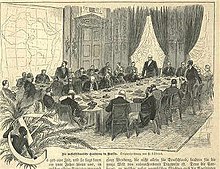
Colonial empires were the product of the European Age of Discovery from the 15th century. The initial impulse behind these dispersed maritime empires and those that followed was trade. Both the Portuguese Empire and Spanish Empire quickly grew into the first global political and economic systems with territories spread around the world.
Subsequent major European colonial empires included the French, Dutch, and British. The latter, consolidated during the period of British maritime hegemony in the 19th century, became the largest empire in history because of the improved ocean transportation technologies of the time as well as electronic communication. At its height in 1920, the British Empire covered a quarter of the Earth's land area and comprised a quarter of its population. Other European countries, such as Belgium, Germany, and Italy, pursued colonial empires as well (mostly in Africa), but they were smaller. Russia built its Russian Empire through conquest by land in Eastern Europe, and Asia.
By the mid-19th century, the Ottoman Empire had declined. This instigated the Crimean War in 1854 and began a tenser period of minor clashes among the globe-spanning empires of Europe. In the second half of the 19th century, the Kingdom of Sardinia and the Kingdom of Prussia carried out a series of wars that resulted in the creation of Italy and Germany as nation-states, significantly changing the balance of power in Europe. From 1870, Otto von Bismarck engineered a German hegemony that put France in a critical situation. It slowly rebuilt its relationships, seeking alliances with Russia and Britain to control the growing power of Germany. In this way, two opposing sides – the Triple Alliance of 1882 (Germany, Austria-Hungary and Italy) and the Triple Entente of 1907 (Britain, France and Russia) – formed in Europe, escalating military forces and alliances.
1914–45: two world wars[edit]
World War I[edit]

After the relative peace of most of the 19th century, the rivalry between European powers, compounded by rising nationalism among ethnic groups, exploded in 1914, when World War I started.[143] Over 65 million European soldiers were mobilised from 1914 to 1918; 20 million soldiers and civilians died.[144] On one side were Germany, Austria-Hungary, the Ottoman Empire and Bulgaria (the Central Powers/Triple Alliance), while on the other side stood Serbia and the Triple Entente(France, Britain and Russia), which were joined by Italy in 1915, Romania in 1916 and the United States in 1917. The Western Front involved especially brutal combat without any territorial gains by either side. Single battles like Verdun and the Somme killed hundreds of thousands. Czarist Russia collapsed in the February Revolution of 1917 and Germany claimed victory on the Eastern Front. After eight months of liberal rule, the October Revolution brought Vladimir Lenin and the Bolsheviks to power, leading to the creation of the Soviet Union. With American entry into the war in 1917, and the failure of Germany's spring 1918 offensive, Germany had run out of manpower. Germany's allies, Austria-Hungary and the Ottoman Empire, surrendered and dissolved, followed by Germany on 11 November 1918.[145][146]

The world war was settled by the victors at the Paris Peace Conference, 1919. The major decisions were the creation of the League of Nations; peace treaties with defeated enemies, most notably the Treaty of Versailles with Germany; the awarding of German and Ottoman overseas possessions as "mandates", chiefly to Britain and France; and the drawing of new national boundaries to better reflect the forces of nationalism.[147][148] Multiple nations were required to sign minority rights treaties.[149] The Treaty of Versailles itself weakened Germany's military power and placed full blame for the war and costly reparations on its shoulders – the humiliation and resentment in Germany was probably one of the causes of Nazi success and indirectly a cause of World War II.
Interwar[edit]
In the Treaty of Versailles (1919) the winners recognised the new states (Poland, Czechoslovakia, Hungary, Austria, Yugoslavia, Finland, Estonia, Latvia, Lithuania) created in central Europe from the defunct German, Austro-Hungarian and Russian empires, based on national (ethnic) self-determination. It was a peaceful era with a few small wars before 1922 such as the Ukrainian–Soviet War (1917–1921) and the Polish–Soviet War (1919–1921). Prosperity was widespread, and the major cities sponsored a youth culture called the "Roaring Twenties" or "Jazz Age".[150]
The Allied victory in the First World War seemed to mark the triumph of liberalism. Historian Martin Blinkhorn argues that the liberal themes were ascendant in terms of "cultural pluralism, religious and ethnic toleration, national self-determination, free-market economics, representative and responsible government, free trade, unionism, and the peaceful settlement of international disputes through a new body, the League of Nations."[151] However, as early as 1917, the emerging liberal order was being challenged by the new communist movement. Communist revolts were beaten back everywhere else, but succeeded in Russia.[152] Italy adopted an authoritarian dictatorship known as Fascism in 1922. Authoritarian regimes replaced democracy in the 1930s in Nazi Germany, Portugal, Austria, Poland, Greece, the Baltic countries and Francoist Spain. By 1940, there were only four liberal democracies left on the European continent: France, Finland, Switzerland and Sweden.[153]
Great Depression: 1929–39[edit]
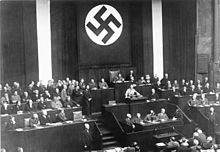
After the Wall Street Crash of 1929, most of the world sank into a Great Depression; prices and profits fell and unemployment soared. The worst hit sectors included heavy industry, export-oriented agriculture, mining and lumbering, and construction. World trade fell by two-thirds.[154][155]
In most of Europe, many nations turned to dictators and authoritarian regimes. The most momentous change of government came when Hitler took power in Germany in 1933. The main institution that was meant to bring stability was the League of Nations, created in 1919. However the League failed to resolve any major crises, undermined by the bellicosity of Nazi Germany, Imperial Japan, the Soviet Union, and Mussolini's Italy, and by the non-participation of the United States. By 1937 it was largely ignored.[156]
Italy conquered Ethiopia in 1931.[157] The Spanish Civil War (1936–1939) was won by the rebels (the Nationalist faction), led by Francisco Franco. The civil war did not escalate into a larger conflict, but did become a worldwide ideological battleground that pitted the left, the communist movement and many liberals against Catholics, conservatives, and fascists. Britain, France and the US remained neutral. Worldwide there was a decline in pacifism and a growing sense that another world war was imminent.[158]
World War II[edit]

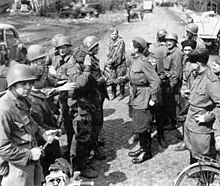
In 1938 Adolf Hitler annexed the Sudetenland. In the Munich Agreement, Britain and France adopted a policy of appeasement, but Germany subsequently took over the rest of Czechoslovakia. After allying with Japan in the Anti-Comintern Pact and then also with Benito Mussolini's Italy in the "Pact of Steel", and finally signing a non-aggression treaty with the Soviet Union in August 1939, Hitler launched the Second World War on 1 September 1939 by attacking Poland. Britain and France declared war on Germany, but there was little fighting during the "Phoney War" period. War began in earnest in spring 1940 with the successful Blitzkrieg conquests of Denmark, Norway, the Low Countries, and France. Britain defeated Germany's air attacks in the Battle of Britain. Hitler's goal was to control Eastern Europe but the attack on the Soviet Union was delayed until June 1941 and the Wehrmacht was stopped close to Moscow in December 1941.[159]
Over the next year the Germans started to suffer a series of defeats. War raged between the Axis Powers (Germany, Italy, and Japan) and the Allied Forces (British Empire, Soviet Union, and the United States). The Allied Forces won in North Africa, invaded Italy in 1943, and recaptured France in 1944. In 1945 Germany itself was invaded from the east by the Soviet Union and from the west by the other Allies. As the Red Army conquered the Reichstag in the Battle of Berlin, Hitler committed suicide and Germany surrendered.[160] World War II was the deadliest conflict in human history, causing between 50 and 80 million deaths, the majority of whom were civilians (approximately 38 to 55 million).[161]
This period was also marked by systematic genocide. In 1942–45, separately from the war-related deaths, the Nazis killed over 11 million civilians identified through IBM-enabled censuses, including the majority of the Jews and Gypsies of Europe, millions of Polish and Soviet Slavs, homosexuals, Jehovah's Witnesses, disabled people, and political enemies. Meanwhile, in the 1930s the Soviet system of forced labour, expulsions and allegedly engineered famine had a similar death toll. Millions of civilians were affected by forced population transfers.[162]
Cold War era[edit]

The world wars ended the pre-eminent position of Britain, France and Germany in Europe and the world.[163] At the Yalta Conference, Europe was divided into spheres of influence between the victors of World War II, and soon became the principal zone of contention in the Cold War between the Western countries and the Communist bloc. The United States and the majority of European liberal democracies established the NATO military alliance. Later, the Soviet Union and its satellites in 1955 established the Warsaw Pact. The Warsaw Pact had a much larger ground force, but the American-French-British nuclear umbrellas protected NATO.
Communist states were imposed by the Red Army in the East, while parliamentary democracy became dominant in the West. Most historians point to its success as the product of exhaustion with war and dictatorship, and the promise of continued economic prosperity.
Economic recovery[edit]

The United States gave away about $20 billion in Marshall Plan grants and other funding to Western Europe, 1945 to 1951. Historian Michael J. Hogan argues that American aid was critical in stabilizing the economy and politics of Western Europe. It brought in modern management that dramatically increased productivity, and encouraged cooperation between labor and management, and among states. Local Communist parties were opposed, and they lost prestige and influence and a role in government. In strategic terms, says Hogan, the Marshall Plan strengthened the West against the possibility of a communist invasion or political takeover.[164] However, the Marshall Plan's role in the rapid recovery has been debated. Most reject the idea that it only miraculously revived Europe, since the evidence shows that a general recovery was already under way. Economic historians Bradford De Long and Barry Eichengreen conclude:
- It was not large enough to have significantly accelerated recovery by financing investment, aiding the reconstruction of damaged infrastructure, or easing commodity bottlenecks. We argue, however, that the Marshall Plan did play a major role in setting the stage for post-World War II Western Europe's rapid growth. The conditions attached to Marshall Plan aid pushed European political economy in a direction that left its post World War II "mixed economies" with more "market" and less "controls" in the mix.[165]
The Soviet Union concentrated on its own recovery. It seized and transferred most of Germany's industrial plants and it exacted war reparations from East Germany, Hungary, Romania, and Bulgaria. It used trading arrangements deliberately designed to favor the Soviet Union. Moscow controlled the Communist parties that ruled the satellite states. Historian Mark Kramer concludes:
- The net outflow of resources from eastern Europe to the Soviet Union was approximately $15 billion to $20 billion in the first decade after World War II, an amount roughly equal to the total aid provided by the United States to western Europe under the Marshall Plan.[166]
Looking at the half century after the war historian Walter Lacquer concluded:
- "The postwar generations of European elites aimed to create more democratic societies. They wanted to reduce the extremes of wealth and poverty and provide essential social services in a way that prewar generations had not. They had had quite enough of unrest and conflict. For decades many Continental societies had more or less achieved these aims and had every reason to be proud of their progress. Europe was quiet and civilized. Europe's success was based on recent painful experience: the horrors of two world wars; the lessons of dictatorship; the experiences of fascism and communism. Above all, it was based on a feeling of European identity and common values – or so it appeared at the time."[167]
The post-war period witnessed a significant rise in the standard of living of the Western European working class.[168]
Western Europe's industrial nations in the 1970s were hit by a global economic crisis. Causes included obsolescent heavy industry, sudden high energy prices which caused sharp inflation, inefficient nationalized railways and heavy industries, lagging computer technology, high government deficits and growing unrest led by militant labour unions. Germany and Sweden sought to create a social consensus behind a gradual restructuring. Germany's efforts proved highly successful. In Britain under the premiership of Margaret Thatcher, the solution was shock therapy, high interest rates, austerity, and selling off inefficient corporations as well as the public housing. One result was escalating social tensions in Britain. Thatcher eventually defeated her opponents and radically changed the British economy, but controversy persisted.[169]
Recent history[edit]

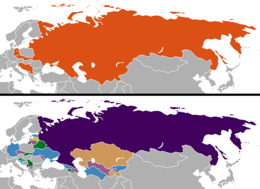
Western Europe began economic and then political integration, with the aim to unite the region and defend it. This process included organisations such as the European Coal and Steel Community and the Council of Europe. The Solidarność movement in the 1980s weakened the Communist government in Poland. At the time the Soviet leader Mikhail Gorbachev initiated perestroika and glasnost, which weakened Soviet influence in Europe. In 1989 after the Pan-European Picnic the Iron Curtain and the Berlin Wall came down and Communist governments outside the Soviet Union were deposed. In 1990 the Federal Republic of Germany absorbed East Germany. In 1991 the Communist Party of the Soviet Union in Moscow collapsed, ending the USSR, which split into fifteen independent states. The most violent dissolution happened in Yugoslavia. Four out of six Yugoslav republics declared independence and for most of them a violent war ensued, in some parts lasting until 1995. In 2006 Montenegro seceded and became an independent state. Kosovo's government unilaterally declared independence from Serbia on 17 February 2008. The European Economic Community pushed for closer integration, co-operation in foreign and home affairs, and started to increase its membership into the neutral and former communist countries. In 1993, the Maastricht Treaty established the European Union, succeeding the EEC. The neutral countries of Austria, Finland and Sweden acceded to the EU, and those that didn't join were tied into the EU's economic market via the European Economic Area. These countries also entered the Schengen Agreement which lifted border controls between member states.[170] The euro was created in 1999 and replaced all previous currencies in participating states in 2002, forming the eurozone.
The EU did not participate in the Yugoslav Wars, and was divided on supporting the United States in the 2003–2011 Iraq War. NATO was part of the war in Afghanistan, but at a much lower level of involvement than the United States.
In the post–Cold War era, NATO and the EU have been gradually admitting most of the former members of the Warsaw Pact. In 2004, the EU gained 10 new members. (Estonia, Latvia, and Lithuania, which had been part of the Soviet Union; Czech Republic, Hungary, Poland, Slovakia, and Slovenia, five former-communist countries; Malta, and the divided island of Cyprus.) These were followed by Bulgaria and Romania in 2007. Russia's regime interpreted these expansions as violations against NATO's promise to not expand "one inch to the east" in 1990.[171] Russia engaged in bilateral disputes about gas supplies with Belarus and Ukraine which endangered the European supply, and engaged in a war with Georgia in 2008. Public opinion in the EU turned against enlargement, partially due to what was seen as over-eager expansion including Turkey gaining candidate status. The European Constitution was rejected in France and the Netherlands, and then (as the Treaty of Lisbon) in Ireland, although a second vote passed in Ireland in 2009.
The financial crisis of 2007–08 affected Europe, and government responded with austerity measures. Limited ability of the smaller EU nations (most notably Greece) to handle their debts led to social unrest, government liquidation, and financial insolvency. In May 2010, the German parliament agreed to loan 22.4 billion euros to Greece over three years, with the stipulation that Greece follow strict austerity measures. See European sovereign-debt crisis.
Beginning in 2014, Ukraine has been in a state of revolution and unrest. On 16 March, a disputed referendum was held in Crimea leading to the de facto secession of Crimea and its largely internationally unrecognized annexation to the Russian Federation.
In June 2016, in a referendum in the United Kingdom on the country's membership in the European Union, 52% of voters voted to leave the EU, leading to the complex Brexit separation process and negotiations, which led to political and economic changes for both the UK and the remaining European Union countries. The UK left the EU on 31 January 2020. Later that year, Europe was affected by the COVID-19 pandemic.
According to the Wall Street Journal in 2021 as Angela Merkel stepped down as Chancellor of Germany after 16 years:
Russia began an invasion of Ukraine on 24 February 2022, in a major escalation of the Russo-Ukrainian War that began in 2014. It is the largest conventional military attack in Europe since World War II.[173][174][175]
Genetic History of Europe
The genetic history of Europe includes information around the formation, ethnogenesis, and other DNA-specific information about populations indigenous, or living in Europe.
The most significant recent dispersal of modern humans from Africa gave rise to an undifferentiated "non-African" lineage by some 70–50 ka (70-50,000 years ago). By about 50–40 ka a West Eurasian lineage had emerged, as had a separate East Eurasian lineage.[2][3][4][5] Both East and West Eurasians acquired Neanderthal admixture in Europe and Asia.[6]
European early modern humans (EEMH) lineages between 40 and 26 ka (Aurignacian) were still part of a large Western Eurasian "meta-population", related to Central and Western Asian populations.[2] Divergence into genetically distinct sub-populations within Western Eurasia is a result of increased selection pressure and founder effects during the Last Glacial Maximum (LGM, Gravettian).[7] By the end of the LGM, after 20 ka, A Western European lineage, dubbed West European Hunter-Gatherer (WHG) emerged from the Solutrean refugium during the European Mesolithic.[8] These mesolithic hunter-gatherer cultures are subsequently replaced in the Neolithic Revolution as a result of the arrival of Early European Farmers (EEF) lineages derived from mesolithic populations of West Asia (Anatolia and the Caucasus).[9] In the European Bronze Age, there were again substantial population replacements in parts of Europe by the intrusion of Western Steppe Herders (WSH) lineages from the Pontic–Caspian steppes, being deeply related to Mesolithic European hunter-gatherers. These Bronze Age population replacements are associated with the Bell Beaker and Corded Ware cultures archaeologically and with the Indo-European expansion linguistically.[10][11]
As a result of the population movements during the Mesolithic to Bronze Age, modern European populations are distinguished by differences in WHG, EEF and Ancient North Eurasian (ANE) ancestry.[12][13][14] Admixture rates varied geographically; in the late Neolithic, WHG ancestry in farmers in Hungary was at around 10%, in Germany around 25% and in Iberia as high as 50%.[15] The contribution of EEF is more significant in Mediterranean Europe, and declines towards northern and northeastern Europe, where WHG ancestry is stronger; the Sardinians are considered to be the closest European group to the population of the EEF.
Ethnogenesis of the modern ethnic groups of Europe in the historical period is associated with numerous admixture events, primarily those associated with the Roman during the Migration period and the Germanic, Norse, Slavic and Turkic expansions.
Research into the genetic history of Europe became possible in the second half of the 20th century, but did not yield results with high resolution before the 1990s. In the 1990s, preliminary results became possible, but they remained mostly limited to studies of mitochondrial and Y-chromosomal lineages. Autosomal DNA became more easily accessible in the 2000s, and since the mid-2010s, results of previously unattainable resolution, many of them based on full-genome analysis of ancient DNA, have been published at an accelerated pace.[16][17]
Prehistory[edit]
Due to natural selection, the percentage of Neanderthal DNA in ancient Europeans gradually decreased over time. From 45,000 BP to 7,000 BP, the percentage dropped from around 3–6% to 2%.[17] The removal of Neanderthal-derived alleles occurred more frequently around genes than other parts of the genome.[17]
Palaeolithic[edit]
Neanderthals inhabited much of Europe and western Asia from as far back as 130,000 years ago. They existed in Europe as late as 30,000 years ago. They were eventually replaced by anatomically modern humans (AMH; sometimes known as Cro-Magnons), who began to appear in Europe circa 40,000 years ago. Given that the two hominid species likely coexisted in Europe, anthropologists have long wondered whether the two interacted.[18] The question was resolved only in 2010, when it was established that Eurasian populations exhibit Neanderthal admixture, estimated at 1.5–2.1% on average.[19] The question now became whether this admixture had taken place in Europe, or rather in the Levant, prior to AMH migration into Europe.
There has also been speculation about the inheritance of specific genes from Neanderthals. For example, one MAPT locus 17q21.3 which is split into deep genetic lineages H1 and H2. Since the H2 lineage seems restricted to European populations, several authors had argued for inheritance from Neanderthals beginning in 2005.[20][21][22][23][24] However the preliminary results from the sequencing of the full Neanderthal Genome at that time (2009), failed to uncover evidence of interbreeding between Neanderthals and modern humans.[25][26] By 2010, findings by Svante Pääbo (Max Planck Institute for Evolutionary Anthropology at Leipzig, Germany), Richard E. Green (University of California, Santa Cruz), and David Reich (Harvard Medical School), comparing the genetic material from the bones of three Neanderthals with that from five modern humans, did show a relationship between Neanderthals and modern people outside Africa.
Upper Paleolithic[edit]

It is thought that modern humans began to inhabit Europe during the Upper Paleolithic about 40,000 years ago. Some evidence shows the spread of the Aurignacian culture.[27]: 59
From a purely patrilineal, Y-chromosome perspective, it is possible that the old Haplogroup C1a2, F and K2a may be those with the oldest presence in Europe. They have been found in some very old human remains in Europe. However, other haplogroups are far more common among living European males because of later demographic changes.
Currently the oldest sample of Haplogroup I (M170), which is now relatively common and widespread within Europe, has been found to be Krems WA3 from Lower Austria dating back to about 30–31,000 ybp.[28] At about this time, an Upper Palaeolithic culture also appeared, known as the Gravettian.[29]
Earlier research into Y-DNA had instead focused on haplogroup R1 (M173): the most populous lineage among living European males; R1 was also believed to have emerged ~ 40,000 BP in Central Asia.[29][30] However, it is now estimated that R1 emerged substantially more recently: a 2008 study dated the most recent common ancestor of haplogroup IJ to 38,500 and haplogroup R1 to 18,000 BP. This suggested that haplogroup IJ colonists formed the first wave and haplogroup R1 arrived much later.[31]
Thus the genetic data suggests that, at least from the perspective of patrilineal ancestry, separate groups of modern humans took two routes into Europe: from the Middle East via the Balkans and another from Central Asia via the Eurasian Steppe, to the north of the Black Sea.
Martin Richards et al. found that 15–40% of extant mtDNA lineages trace back to the Palaeolithic migrations (depending on whether one allows for multiple founder events).[32] MtDNA haplogroup U5, dated to be ~ 40–50 kYa, arrived during the first early upper Palaeolithic colonisation. Individually, it accounts for 5–15% of total mtDNA lineages. Middle U.P. movements are marked by the haplogroups HV, I and U4. HV split into Pre-V (around 26,000 years old) and the larger branch H, both of which spread over Europe, possibly via Gravettian contacts.[29][33]
Haplogroup H accounts for about half the gene lines in Europe, with many subgroups. The above mtDNA lineages or their precursors, are most likely to have arrived into Europe via the Middle East. This contrasts with Y DNA evidence, whereby some 50%-plus of male lineages are characterised by the R1 superfamily, which is of possible central Asian origin.[citation needed] Ornella Semino postulates that these differences "may be due in part to the apparent more recent molecular age of Y chromosomes relative to other loci, suggesting more rapid replacement of previous Y chromosomes. Gender-based differential migratory demographic behaviors will also influence the observed patterns of mtDNA and Y variation"[citation needed].
Last Glacial Maximum[edit]
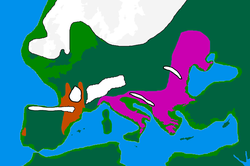
The Last Glacial Maximum ("LGM") started c. 30 ka BCE, at the end of MIS 3, leading to a depopulation of Northern Europe. According to the classical model, people took refuge in climatic sanctuaries (or refugia) as follows:
- Northern Iberia and Southwest France, together making up the "Franco-Cantabrian" refugium
- The Balkans
- Ukraine and more generally the northern coast of the Black Sea[29]
- Italy.[34]
This event decreased the overall genetic diversity in Europe, a "result of drift, consistent with an inferred population bottleneck during the Last Glacial Maximum".[30] As the glaciers receded from about 16,000–13,000 years ago, Europe began to be slowly repopulated by people from refugia, leaving genetic signatures.[29]
Some Y haplogroup I clades appear to have diverged from their parental haplogroups sometime during or shortly after the LGM.[35]
Cinnioglu sees evidence for the existence of an Anatolian refuge, which also harboured Hg R1b1b2.[36] Today, R1b dominates the y chromosome landscape of western Europe, including the British Isles, suggesting that there could have been large population composition changes based on migrations after the LGM.
Semino, Passarino and Pericic place the origins of haplogroup R1a within the Ukrainian ice-age refuge. Its current distribution in eastern Europe and parts of Scandinavia are in part reflective of a re-peopling of Europe from the southern Russian/Ukrainian steppes after the Late Glacial Maximum.[37][38][29]
From an mtDNA perspective, Richards et al. found that the majority of mtDNA diversity in Europe is accounted for by post-glacial re-expansions during the late upper Palaeolithic/ Mesolithic. "The regional analyses lend some support to the suggestion that much of western and central Europe was repopulated largely from the southwest when the climate improved. The lineages involved include much of the most common haplogroup, H, as well as much of K, T, W, and X." The study could not determine whether there were new migrations of mtDNA lineages from the near east during this period; a significant input was deemed unlikely.[32]
The alternative model of more refugees was discussed by Bilton et al.[39]
From a study of 51 individuals, researchers were able to identify five separate genetic clusters of ancient Eurasians during the LGM: the Věstonice Cluster (34,000–26,000 years ago), associated with the Gravettian culture; the Mal'ta Cluster (24,000–17,000), associated with the Mal'ta-Buret' culture, the El Mirón Cluster (19,000–14,000 years ago), associated with the Magdalenian culture; the Villabruna Cluster (14,000–7,000 years ago) and the Satsurblia Cluster (13,000 to 10,000 years ago).[17]
From around 37,000 years ago, all ancient Europeans began to share some ancestry with modern Europeans.[17] This founding population is represented by GoyetQ116-1, a 35,000 year old specimen from Belgium.[17] This lineage disappears from the record and is not found again until 19,000 BP in Spain at El Mirón, which shows strong affinities to GoyetQ116-1.[17] During this interval, the distinct Věstonice Cluster is predominant in Europe, even at Goyet.[17] The re-expansion of the El Mirón Cluster coincided with warming temperatures following the retreat of the glaciers during the Last Glacial Maximum.[17] From 37,000 to 14,000 years ago, the population of Europe consisted of an isolated population descended from a founding population that didn't interbreed significantly with other populations.[40]
Mesolithic[edit]
Mesolithic (post-LGM) populations had diverged significantly due to their relative isolation over several millennia, to the harsh selection pressures during the LGM, and to the founder effects caused by the rapid expansion from LGM refugia in the beginning Mesolithic.[7] By the end of the LGM, around 19 to 11 ka, the familiar varieties of Eurasian phenotypes had emerged. However, the lineage of Mesolithic hunter-gatherers of Western Europe (WHG) does not survive as a majority contribution in any modern population. They were most likely blue eyed, and retained the dark skin pigmentation of pre-LGM EEMH.[41] The HERC2 and OCA2 variations for blue eyes are derived from the WHG lineage were also found in the Yamnaya people.[41][contradictory]
Around 14,000 years ago, the Villabruna Cluster shifted away from GoyetQ116-1 affinity and started to show more affinity with the Near East, a shift which coincided with the warming temperatures of the Bølling-Allerød interstadial.[17] This genetic shift shows that Near East populations had probably already begun moving into Europe during the end of the Upper Paleolithic, about 6,000 years earlier than previously thought, before the introduction of farming.[40] A few specimens from the Villabruna Cluster also show genetic affinities for East Asians that are derived from gene flow.[17][40] The HERC2 variation for blue eyes first appears around 13,000 to 14,000 years ago in Italy and the Caucasus.[17] The light skin pigmentation characteristic of modern Europeans is estimated to have spread across Europe in a "selective sweep" during the Mesolithic (19 to 11 ka). The associated TYRP1 SLC24A5 and SLC45A2 alleles emerge around 19 ka, still during the LGM, most likely in the Caucasus.[7][8]
Neolithic[edit]

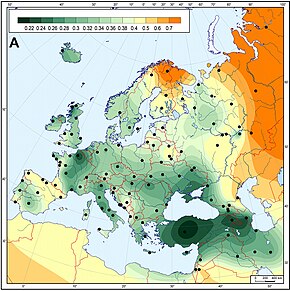
A big cline in genetic variation that has long been recognised in Europe seems to show important dispersals from the direction of the Middle East. This has often been linked to the spread of farming technology during the Neolithic, which has been argued to be one of the most important periods in determining modern European genetic diversity.
The Neolithic started with the introduction of farming, beginning in SE Europe approximately 10,000–3000 BCE, and extending into NW Europe between 4500 and 1700 BCE. During this era, the Neolithic revolution led to drastic economic as well as socio-cultural changes in Europe and this is also thought to have had a big effect on Europe's genetic diversity, especially concerning genetic lineages entering Europe from the Middle East into the Balkans. There were several phases of this period:
- In a late European Mesolithic prelude to the Neolithic, it appears that Near Eastern peoples from areas that already had farming, and who also had sea-faring technology, had a transient presence in Greece (for example at Franchthi Cave).[44][45]
- There is consensus that agricultural technology and the main breeds of animals and plants which are farmed entered Europe from somewhere in the area of the Fertile Crescent and specifically the Levant region from the Sinai to Southern Anatolia.[27]: 1143, 1150 [46] (Less certainly, this agricultural revolution is sometimes argued to have in turn been partly triggered by movements of people and technology coming across the Sinai from Africa.) For more see Fertile Crescent: Cosmopolitan diffusion.
- A later stage of the Neolithic, the so-called Pottery Neolithic, saw an introduction of pottery into the Levant, Balkans and Southern Italy (it had been present in the area of modern Sudan for some time before it is found in the Eastern Mediterranean, but it is thought to have developed independently), and this may have also been a period of cultural transfer from the Levant into the Balkans.
An important issue regarding the genetic impact of neolithic technologies in Europe is the manner by which they were transferred into Europe. Farming was introduced by a significant migration of farmers from the Near East (Cavalli-Sforza's biological demic diffusion model) or a "cultural diffusion" or a combination of the two, and population geneticists have tried to clarify whether any genetic signatures of Near Eastern origin correspond to the expansion routes postulated by the archaeological evidence.[27]: 146
Martin Richards estimated that only 11% of European mtDNA is due to immigration in this period, suggesting that farming was spread primarily due to being adopted by indigenous Mesolithic populations, rather than due to immigration from Near East. Gene flow from SE to NW Europe seems to have continued in the Neolithic, the percentage significantly declining towards the British Isles. Classical genetics also suggested that the largest admixture to the European Paleolithic/Mesolithic stock was due to the Neolithic revolution of the 7th to 5th millennia BCE.[47] Three main mtDNA gene groups have been identified as contributing Neolithic entrants into Europe: J, T1 and U3 (in that order of importance). With others, they amount up to around 20% of the gene pool.[32]
In 2000, Semino's study on Y DNA revealed the presence of haplotypes belonging to the large clade E1b1b1 (E-M35). These were predominantly found in the southern Balkans, southern Italy and parts of Iberia. Semino connected this pattern, along with J haplogroup subclades, to be the Y-DNA component of Cavalli-Sforza's Neolithic demic-diffusion of farmers from the Near East.[29]: Here, the clade E-M35 is referred to as "Eu 4" Rosser et al. rather saw it as a (direct) 'North African component' in European genealogy, although they did not propose a timing and mechanism to account for it.[48][49] also described E1b1b as representing a late-Pleistocene migration from Africa to Europe over the Sinai Peninsula in Egypt, evidence for which does not show up in mitochondrial DNA.[50]
Concerning timing the distribution and diversity of V13 however, Battaglia[51] proposed an earlier movement whereby the E-M78* lineage ancestral to all modern E-V13 men moved rapidly out of a Southern Egyptian homeland and arrived in Europe with only Mesolithic technologies. They then suggest that the E-V13 sub-clade of E-M78 only expanded subsequently as native Balkan 'foragers-cum-farmers' adopted Neolithic technologies from the Near East. They propose that the first major dispersal of E-V13 from the Balkans may have been in the direction of the Adriatic Sea with the Neolithic Impressed Ware culture often referred to as Impressa or Cardial,[37] rather propose that the main route of E-V13 spread was along the Vardar-Morava-Danube river 'highway' system.
In contrast to Battaglia, Cruciani[52] tentatively suggested (i) a different point where the V13 mutation happened on its way from Egypt to the Balkans via the Middle East, and (ii) a later dispersal time. The authors proposed that the V13 mutation first appeared in western Asia, where it is found in low but significant frequencies, whence it entered the Balkans sometime after 11 kYa. It later experienced a rapid dispersal which he dated to c. 5300 years ago in Europe, coinciding with the Balkan Bronze Age. Like Peričic et al. they consider that "the dispersion of the E-V13 and J-M12 haplogroups seems to have mainly followed the river waterways connecting the southern Balkans to north-central Europe".
More recently, Lacan[53] announced that a 7000-year-old skeleton in a Neolithic context in a Spanish funeral cave, was an E-V13 man. (The other specimens tested from the same site were in haplogroup G2a, which has been found in Neolithic contexts throughout Europe.) Using 7 STR markers, this specimen was identified as being similar to modern individuals tested in Albania, Bosnia, Greece, Corsica, and Provence. The authors therefore proposed that, whether or not the modern distribution of E-V13 of today is a result of more recent events, E-V13 was already in Europe within the Neolithic, carried by early farmers from the Eastern Mediterranean to the Western Mediterranean, much earlier than the Bronze Age. This supports the proposals of Battaglia et al. rather than Cruciani et al. at least concerning earliest European dispersals, but E-V13 may have dispersed more than once. Even more recent than the Bronze Age, it has also been proposed that modern E-V13's modern distribution in Europe is at least partly caused by Roman era movements of people.[54] (See below.)
The migration of Neolithic farmers into Europe brought along several new adaptations.[41] The variation for light skin colour was introduced to Europe by the neolithic farmers.[41] After the arrival of the neolithic farmers, a SLC22A4 mutation was selected for, a mutation which probably arose to deal with ergothioneine deficiency but increases the risk of ulcerative colitis, coeliac disease, and irritable bowel syndrome.
Bronze Age[edit]
The Bronze Age saw the development of long-distance trading networks, particularly along the Atlantic Coast and in the Danube valley. There was migration from Norway to Orkney and Shetland in this period (and to a lesser extent to mainland Scotland and Ireland). There was also migration from Germany to eastern England. Martin Richards estimated that there was about 4% mtDNA immigration to Europe in the Bronze Age.
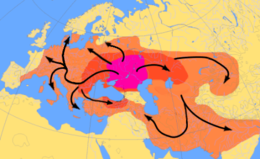
Another theory about the origin of the Indo-European language centres around a hypothetical Proto-Indo-European people, who, according to the Kurgan hypothesis, can be traced to north of the Black and Caspian Seas at about 4500 BCE.[55] They domesticated the horse and possibly invented the wooden disk wheel, and are considered to have spread their culture and genes across Europe.[56] The Y haplogroup R1a is a proposed marker of these "Kurgan" genes, as is the Y Haplogroup R1b, although these haplogroups as a whole may be much older than the language family.[57]
In the far north, carriers of the Y-haplogroup N arrived to Europe from Siberia, eventually expanding as far as Finland, though the specific timing of their arrival is uncertain. The most common North European subclade N1c1 is estimated to be around 8,000 years old. There is evidence of human settlement in Finland dating back to 8500 BCE, linked with the Kunda culture and its putative ancestor, the Swiderian culture, but the latter is thought to have a European origin. The geographical spread of haplogroup N in Europe is well aligned with the Pit–Comb Ware culture, whose emergence is commonly dated c. 4200 BCE, and with the distribution of Uralic languages. Mitochondrial DNA studies of Sami people, haplogroup U5 are consistent with multiple migrations to Scandinavia from Volga-Ural region, starting 6,000 to 7,000 years before present.[58]
The relationship between roles of European and Asian colonists in the prehistory of Finland is a point of some contention, and some scholars insist that Finns are "predominantly Eastern European and made up of people who trekked north from the Ukrainian refuge during the Ice Age".[59] Farther east, the issue is less contentious. Haplogroup N carriers account for a significant part of all non-Slavic ethnic groups in northern Russia, including 37% of Karelians, 35% of Komi people (65% according to another study[60]), 67% of Mari people, as many as 98% of Nenets people, 94% of Nganasans, and 86% to 94% of Yakuts.[61]
The Yamnaya component contains partial ancestry from an Ancient North Eurasian component, a Paleolithic Siberian lineage but closely related to European hunter-gatherers, first identified in Mal'ta.[62][63] According to Iosif Lazaridis, "the Ancient North Eurasian ancestry is proportionally the smallest component everywhere in Europe, never more than 20 percent, but we find it in nearly every European group we’ve studied."[64] This genetic component does not come directly from the Mal'ta lineage itself, but a related lineage that separated from the Mal'ta lineage.[17]
Up to a half of the Yamnaya component may have come from a Caucasus hunter-gatherer strand.[62] On November 16, 2015, in a study published in the journal Nature Communications,[62] geneticists announced that they had found a new fourth ancestral "tribe" or "strand" which had contributed to the modern European gene pool. They analysed genomes from two hunter-gatherers from Georgia which were 13,300 and 9,700 years old, and found that these Caucasus hunter-gatherers were probably the source of the farmer-like DNA in the Yamna. According to co-author Dr Andrea Manica of the University of Cambridge: "The question of where the Yamnaya come from has been something of a mystery up to now....we can now answer that as we've found that their genetic make-up is a mix of Eastern European Hunter-Gatherers and a population from this pocket of Caucasus hunter-gatherers who weathered much of the last Ice Age in apparent isolation."[65]
According to Lazaridis et al. (2016), a population related to the people of the Chalcolithic Iran contributed to roughly half of the ancestry of Yamnaya populations of the Pontic–Caspian steppe. These Iranian Chalcolithic people were a mixture of "the Neolithic people of western Iran, the Levant, and Caucasus Hunter Gatherers."[66]
The genetic variations for lactase persistence and greater height came with the Yamnaya people.[41] The derived allele of the KITLG gene (SNP rs12821256) that is associated with – and likely causal for – blond hair in Europeans is found in populations with Eastern but not Western Hunter-Gatherers ancestry, suggesting that its origin is in the Ancient North Eurasian (ANE) population and may have been spread in Europe by individuals with steppe ancestry. Consistent with this, the earliest known individual with the derived allele is an ANE individual from the Late Upper Paleolithic Afontova Gora archaeological complex in central Siberia.[67]
Recent history[edit]
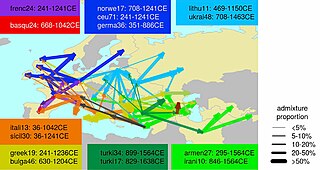
During the period of the Roman Empire, historical sources show that there were many movements of people around Europe, both within and outside the Empire. Historic sources sometimes cite instances of genocide inflicted by the Romans upon rebellious provincial tribes. If this did in fact occur, it would have been limited given that modern populations show considerable genetic continuity in their respective regions.[citation needed] The process of 'Romanisation' appears to have been accomplished by the colonisation of provinces by a few Latin speaking administrators, military personnel, settled veterans, and private citizens (merchants, traders) who emanated from the Empire's various regions (and not merely from Roman Italy). They served as a nucleus for the acculturation of local notables.[69]
Given their small numbers and varied origins, Romanization does not appear to have left distinct genetic signatures in Europe. Indeed, Romance-speaking populations in the Balkans, like Romanians, Aromanians, Moldovans, etc. have been found to genetically resemble neighbouring Greek and South Slavic-speaking peoples rather than modern Italians.[70][71] Steven Bird has speculated that E1b1b1a was spread during the Roman era through Thracian and Dacian populations from the Balkans into the rest of Europe.[54]
Concerning the late Roman period of (not only) Germanic "Völkerwanderung", some suggestions have been made, at least for Britain, with Y haplogroup I1a being associated with Anglo-Saxon immigration in eastern England, and R1a being associated with Norse immigration in northern Scotland.[72]
Genetics of modern European populations[edit]
Patrilineal studies[edit]
There are four main Y-chromosome DNA haplogroups that account for most of Europe's patrilineal descent.[29]
- Haplogroup R1b is common in Europe, particularly in Western Europe, with the R1b1a1a2 being the most common among Western Europeans.[73][74][75] Nearly all of this R1b in Europe is in the form of the R1b1a2 (2011 name) (R-M269) sub-clade, specifically within the R-L23 sub-sub-clade whereas R1b found in Central Asia, western Asia and Africa tends to be in other clades. It has also been pointed out that outlier types are present in Europe and are particularly notable in some areas such as Sardinia and Armenia.[76] Haplogroup R1b frequencies vary from highs in western Europe in a steadily decreasing cline with growing distance from the Atlantic: 80–90% (Welsh, Basque, Irish, Scots, Bretons) around 70–80% in Spain, Britain and France and around 40–60% in parts of eastern Germany, and northern Italy. It drops outside this area and is around 30% or less in areas such as southern Italy, Poland, the Balkans and Cyprus. R1b remains the most common clade as one moves east to Germany, while farther east, in Poland, R1a is more common (see below).[77] In Southeast Europe, R1b drops behind R1a in the area in and around Hungary and Serbia but is more common both to the south and north of this region.[37] R1b in Western Europe is dominated by at least two sub-clades, R-U106, which is distributed from the east side of the Rhine into northern and central Europe (with a strong presence in England) and R-P312, which is most common west of the Rhine, including the British Isles.[74][75]
- Haplogroup R1a, almost entirely in the R1a1a sub-clade, is prevalent in much of Eastern and Central Europe (also in South and Central Asia). For example, there is a sharp increase in R1a1 and decrease in R1b1b2 as one goes east from Germany to Poland.[77] It also has a substantial presence in Scandinavia (particularly Norway).[78][79] In the Baltic countries R1a frequencies decrease from Lithuania (45%) to Estonia (around 30%).[80]
- Haplogroup I is found in the form of various sub-clades throughout Europe and is found at highest frequencies in the Nordic countries as I1 (Norway, Denmark, Sweden, Finland) and in the Balkan Peninsula as I2a (Bosnia and Herzegovina 65%,[60] Croatia and Serbia). I1 is also frequent in Germany, Great Britain and Netherlands, while I2a is frequent also in Sardinia, Romania/Moldova, Bulgaria and Ukraine. This clade is found at its highest expression by far in Europe and may have been there since before the LGM.[35]
- Haplogroup E1b1b (formerly known as E3b) was part of a migration of Neolithic farmers from the Middle East, which carried E1b1b at low to medium frequency and was introduced into Neolithic Middle Easterners throughout genetic drift from a migration from Africa into the Middle East associated with the Afroasiatic languages. It is believed to have first appeared in Northeast Africa approximately 26,000 years ago and dispersed to North Africa and the Near East during the late Paleolithic and Mesolithic periods. E1b1b lineages are closely linked to the diffusion of Afroasiatic languages. Although present throughout Europe, it peaks in the southern Balkan region amongst Albanians and their neighbors. It is also common in Italy and the Iberian peninsula at lower frequency. Haplogroup E1b1b1, mainly in the form of its E1b1b1a2 (E-V13) sub-clade, reaches frequencies above 47% around the area of Kosovo.[37] This clade is thought to have arrived in Europe from western Asia either in the later Mesolithic,[51] or the Neolithic.[81] North Africa subclade E-M81 is also present in Sicily and Andalusia.
Putting aside small enclaves, there are also several haplogroups apart from the above four that are less prominent or most common only in certain areas of Europe.
- Haplogroup G, a common haplogroup among European Neolithic farmers, is common in most parts of Europe at a low frequency, reaching peaks above 70% around Georgia and among the Madjars (although living in Asia they border the eastern perimeter of Europe), up to 10% in Sardinia, 12% in Corsica and Uppsala (Sweden), 11% in the Balkans and Portugal, 10% in Spain and 9% in European Russia. This clade is also found in the Near East.
- Haplogroup N, is common only in the northeast of Europe and in the form of its N1c1 sub-clade reaches frequencies of approximately 60% among Finns and approximately 40% among Estonians, Latvians, and Lithuanians.
- Haplogroup J2, in various sub-clades (J2a, J2b), is found in levels of around 15–30% in the Balkans (particularly Greece) and Italy. Haplogroup J2 is frequent in Western Asia and the Eastern Mediterranean.[82]
Matrilineal studies[edit]
There have been a number of studies about the mitochondrial DNA haplogroups (mtDNA) in Europe. In contrast to Y DNA haplogroups, mtDNA haplogroups did not show as much geographical patterning, but were more evenly ubiquitous. Apart from the outlying Saami, all Europeans are characterised by the predominance of haplogroups H, U and T. The lack of observable geographic structuring of mtDNA may be due to socio-cultural factors, namely the phenomena of polygyny and patrilocality.[48]
Genetic studies suggest some maternal gene flow to eastern Europe from eastern Asia or southern Siberia 13,000 – 6,600 years BP.[83] Analysis of Neolithic skeletons in the Great Hungarian Plain found a high frequency of eastern Asian mtDNA haplogroups, some of which survive in modern eastern European populations.[83] Maternal gene flow to Europe from sub-Saharan Africa began as early as 11,000 years BP, although the majority of lineages, approximately 65%, are estimated to have arrived more recently, including during the Romanization period, the Arab conquests of southern Europe, and during the Atlantic slave trade.[84]
European population sub-structure[edit]
Genetically, Europe is relatively homogeneous, but distinct sub-population patterns of various types of genetic markers have been found,[85] particularly along a southeast–northwest cline.[86] For example, Cavalli-Sforza's principal component analyses revealed five major clinal patterns throughout Europe, and similar patterns have continued to be found in more recent studies.[85]: 291–296
- A cline of genes with highest frequencies in the Middle East, spreading to lowest levels northwest. Cavalli-Sforza originally described this as faithfully reflecting the spread of agriculture in Neolithic times. This has been the general tendency in interpretation of all genes with this pattern.
- A cline of genes with highest frequencies among Finnish and Sami in the extreme north east, and spreading to lowest frequencies in the south west.
- A cline of genes with highest frequencies in the area of the lower Don and Volga rivers in southern Russia, and spreading to lowest frequencies in Spain, Southern Italy, Greece and the areas inhabited by Saami speakers in the extreme north of Scandinavia. Cavalli-Sforza associated this with the spread of Indo-European languages, which he links in turn to a "secondary expansion" after the spread of agriculture, associated with animal grazing.
- A cline of genes with highest frequencies in the Balkans and Southern Italy, spreading to lowest levels in Britain and the Basque country. Cavalli-Sforza associates this with "the Greek expansion, which reached its peak in historical times around 1000 and 500 BCE but which certainly began earlier".
- A cline of genes with highest frequencies in the Basque country, and lower levels beyond the area of Iberia and Southern France. In perhaps the most well-known conclusion from Cavalli-Sforza, this weakest of the five patterns was described as isolated remnants of the pre-Neolithic population of Europe, "who at least partially withstood the expansion of the cultivators". It corresponds roughly to the geographical spread of rhesus negative blood types. In particular, the conclusion that the Basques are a genetic isolate has become widely discussed, but also a controversial conclusion.
He also created a phylogenetic tree to analyse the internal relationships among Europeans. He found four major 'outliers'- Basques, Sami, Sardinians and Icelanders;[87] a result he attributed to their relative isolation (note: the Icelanders and the Sardinians speak Indo-European languages, while the other two groups do not). Greeks and Yugoslavs represented a second group of less extreme outliers. The remaining populations clustered into several groups : "Celtic", "Germanic", "south-western Europeans", "Scandinavians" and "eastern Europeans".[85]: 268
A study conducted in May of 2009[88] researching 19 populations from Europe using 270,000 SNPs highlighted the genetic diversity of European populations corresponding to the northwest to southeast gradient and distinguished "four several distinct regions" within Europe:
- Finland, showing the greatest distance to the rest of Europeans.
- the Baltic region (Estonia, Latvia and Lithuania), western Russia and eastern Poland.
- Central and Western Europe.
- Italy, due to the alps acting as a great genetic barrier.
In this study, barrier analysis revealed "genetic barriers" between Finland, Italy and other countries and that barriers could also be demonstrated within Finland (between Helsinki and Kuusamo) and Italy (between northern and southern part, Fst=0.0050). Fst (Fixation index) was found to correlate considerably with geographic distances ranging from ≤0.0010 for neighbouring populations to 0.0200–0.0230 for Southern Italy and Finland. For comparisons, pair-wise Fst of non-European samples were as follows: Europeans – Africans (Yoruba) 0.1530; Europeans – Chinese 0.1100; Africans (Yoruba) – Chinese 0.1900.[89]
A study by Chao Tian in August 2009 extended the analysis of European population genetic structure to include additional southern European groups and Arab populations (Palestinians, Druzes...) from the Near-East. This study determined autosomal Fst between 18 population groups and concluded that, in general, genetic distances corresponded to geographical relationships with smaller values between population groups with origins in neighbouring countries/regions (for example, Greeks/Tuscans: Fst=0.0010, Greeks/Palestinians: Fst=0.0057) compared with those from very different regions in Europe (for example Greeks/Swedish: Fst=0.0087, Greeks/Russians: Fst=0.0108).[90]
Autosomal DNA[edit]
Seldin (2006) used over 5,000 autosomal SNPs. It showed "a consistent and reproducible distinction between ‘northern’ and ‘southern’ European population groups". Most individual participants with southern European ancestry (Italians, Greeks, Portuguese, Spaniards), and Ashkenazi Jews have >85% membership in the southern population; and most northern, western, central, and eastern Europeans (Swedes, English, Irish, Germans, and Ukrainians) have >90% in the northern population group. Many of the participants in this study were American citizens who self-identified with different European ethnicities based on self-reported familial pedigree.[91]
A similar study in 2007 using samples predominantly from Europe found that the most important genetic differentiation in Europe occurs on a line from the north to the south-east (northern Europe to the Balkans), with another east–west axis of differentiation across Europe. Its findings were consistent with earlier results based on mtDNA and Y-chromosomal DNA that support the theory that modern Iberians (Spanish and Portuguese) hold the most ancient European genetic ancestry, as well as separating Basques and Sami from other European populations.[92]
It suggested that the English and Irish cluster with other Northern and Eastern Europeans such as Germans and Poles, while some Basque and Italian individuals also clustered with Northern Europeans. Despite these stratifications, it noted that "there is low apparent diversity in Europe with the entire continent-wide samples only marginally more dispersed than single population samples elsewhere in the world".[92]
In 2008, two international research teams published analyses of large-scale genotyping of large samples of Europeans, using over 300,000 autosomal SNPs. With the exception of usual isolates such as Basques, Finns and Sardinians, the European population lacked sharp discontinuities (clustering) as previous studies have found (see Seldin et al. 2006 and Bauchet et al. 2007[92]), although there was a discernible south to north gradient. Overall, they found only a low level of genetic differentiation between subpopulations, and differences which did exist were characterised by a strong continent-wide correlation between geographic and genetic distance. In addition, they found that diversity was greatest in southern Europe due a larger effective population size and/or population expansion from southern to northern Europe.[86] The researchers take this observation to imply that genetically, Europeans are not distributed into discrete populations.[93][86]
Two whole-genome studies of the two Eastern European populations in Ukraine (Ukrainians from Ukraine) and Russia (Russians from Russia) showed genomic diversity from this region has not been represented in the previous genomic surveys, as studies in Europe are mostly biased towards the populations in the western part of the continent.[94][95] Within Russia, Komi people that live in the north eastern part of the country, and are part of the Uralic language family that also includes Finns, form a pole of genetic diversity that is distinct from other populations, and characterized by a higher European hunter-gatherer (WHG) and Ancient North Eurasian ancestry.[96][97]
According to geneticist David Reich, based on ancient human genomes that his laboratory sequenced in 2016, Europeans descend from a mixture of four West-Eurasian ancestral components, namely WHG (Western Hunter-gatherers), EHG (Eastern Hunter-gatherers), Neolithic farmers from the Levant/Anatolia as well as from Neolithic farmers from Iran (often summarized as "EEF"; Early European farmers), in varying degrees.[98][99]
Siberian geneflow is found among several Uralic-speaking European ethnic groups. This Siberian component is itself a composition of Ancient North Eurasian and East Asian-related ancestry from Eastern Siberia, maximized among Evenks and Evens or Nganasans. The spread of this ancestry is linked by some geneticists to the dispersal of Uralic languages, others however maintain that the Uralic languages spread prior to the arrival of Siberian geneflow, which is a secondary source of diversity within Uralic-speaking populations.[100][101] Genetic data points to a Western Siberian hunter-gatherer origin of the observed Siberian geneflow among Uralic-speaking groups. Western Siberian hunter-gatherers were characterized by high Ancient North Eurasian ancestry and lower amounts of Eastern Siberian admixture. Genetic data on Volga Tatars or Chuvash, found among "Western Turkic speakers, like Chuvash and Volga Tatar, the East Asian component was detected only in low amounts (~ 5%)".[102][103]
East Asian ancestry is found at low frequency among some Europeans. According to one study, Germans, French people and Britons carry anywhere from 1% to 3.8%. Northeastern Russians and Finns were found to have significantly higher East Asian admixture, around 13%. East Asian ancestry was acquired around 1800 years ago in Finns (2nd century AD), while the admixture in Northeast Russians is traced back to around 1300 years ago (8th century AD).[104] The Lipka Tatars, a Turkic minority in Belarus carry around ~30% East Eurasian ancestry.
Modern Europeans are genetically rather homogeneous and derive their ancestry - predominantly to exclusively - from up to five West-Eurasian lineages, in varying degrees. Modern Europeans show affinity and continuity to ancient European hunter-gatherers (Western European Hunter-Gatherers, Scandinavian Hunter-Gatherers, and Eastern European Hunter-Gatherers), yet modern Europeans are significantly closer to Middle Easterners than ancient ones, largely explained through the more recent Neolithic Expansion of farmers from Anatolia towards Europe. Europeans, compared to Middle Easterners, have less "basal" ancestry (ancestry inferred to have diverged before the diverging of Mesolithic European hunter-gatherers and Ancient North Eurasians, therefore representing deep substructure among West-Eurasians), which is inferred to have arrived with Early European farmers (EEF). Europeans contrary have higher Ancient North Eurasian affinity, which is inferred to have arrived with Bronze and Iron Age migrations from Western Siberia. Overall, Europeans cluster closely together with Middle Eastern and South-Central Asian populations, followed by Northern African and South Asian populations, while being most distant from Sub-Saharan African (specifically Central/West African) and Eastern Asian populations.[105]
Autosomal genetic distances (Fst) based on SNPs (2009)[edit]
The genetic distance between populations is often measured by Fixation index (Fst), based on genetic polymorphism data, such as single-nucleotide polymorphisms (SNPs) or microsatellites. Fst is a special case of F-statistics, the concept developed in the 1920s by Sewall Wright. Fst is simply the correlation of randomly chosen alleles within the same sub-population relative to that found in the entire population. It is often expressed as the proportion of genetic diversity due to allele frequency differences among populations.
The values range from 0 to 1. A zero value implies that the two populations are panmictic, that they are interbreeding freely. A value of one would imply that the two populations are completely separate. The greater the Fst value, the greater the genetic distance. Essentially, these low Fst values suggest that the majority of genetic variation is at the level of individuals within the same population group (~ 85%); whilst belonging to a different population group within same ‘race’/ continent, and even to different racial/ continental groups added a much smaller degree of variation (3–8%; 6–11%, respectively).
| Italian Americans | Palestinians | Swedes | Druzes | Spaniards | Germans | Russians | Irish | Greek Americans | Ashkenazi Jews | Circassians | |
|---|---|---|---|---|---|---|---|---|---|---|---|
| Italian Americans | 0.0064 | 0.0064 | 0.0057 | 0.0010 | 0.0029 | 0.0088 | 0.0048 | 0.0000 | 0.0040 | 0.0067 | |
| Palestinians | 0.0064 | 0.0191 | 0.0064 | 0.0101 | 0.0136 | 0.0202 | 0.0170 | 0.0057 | 0.0093 | 0.0108 | |
| Swedes | 0.0064 | 0.0191 | 0.0167 | 0.0040 | 0.0007 | 0.0030 | 0.0020 | 0.0084 | 0.0120 | 0.0117 | |
| Druzes | 0.0057 | 0.0064 | 0.0167 | 0.0096 | 0.0121 | 0.0194 | 0.0154 | 0.0052 | 0.0088 | 0.0092 | |
| Spaniards | 0.0010 | 0.0101 | 0.0040 | 0.0096 | 0.0015 | 0.0070 | 0.0037 | 0.0035 | 0.0056 | 0.0090 | |
| Germans | 0.0029 | 0.0136 | 0.0007 | 0.0121 | 0.0015 | 0.0030 | 0.0010 | 0.0039 | 0.0072 | 0.0089 | |
| Russians | 0.0088 | 0.0202 | 0.0030 | 0.0194 | 0.0070 | 0.0030 | 0.0038 | 0.0108 | 0.0137 | 0.0120 | |
| Irish | 0.0048 | 0.0170 | 0.0020 | 0.0154 | 0.0037 | 0.0010 | 0.0038 | 0.0067 | 0.0109 | 0.0110 | |
| Greek Americans | 0.0000 | 0.0057 | 0.0084 | 0.0052 | 0.0035 | 0.0039 | 0.0108 | 0.0067 | 0.0042 | 0.0054 | |
| Ashkenazi Jews | 0.0040 | 0.0093 | 0.0120 | 0.0088 | 0.0056 | 0.0072 | 0.0137 | 0.0109 | 0.0042 | 0.0107 | |
| Circassians | 0.0067 | 0.0108 | 0.0117 | 0.0092 | 0.0090 | 0.0089 | 0.0120 | 0.0110 | 0.0054 | 0.0107 |
| Austria | Bulgaria | Czech Republic | Estonia | Finland (Helsinki) | Finland (Kuusamo) | France | Northern Germany | Southern Germany | Hungary | Northern Italy | Southern Italy | Latvia | Lithuania | Poland | Russia | Spain | Sweden | Switzerland | CEU | ||
|---|---|---|---|---|---|---|---|---|---|---|---|---|---|---|---|---|---|---|---|---|---|
| Austria | 1.14 | 1.08 | 1.58 | 2.24 | 3.30 | 1.16 | 1.10 | 1.04 | 1.04 | 1.49 | 1.79 | 1.85 | 1.70 | 1.19 | 1.47 | 1.41 | 1.21 | 1.19 | 1.12 | Austria | |
| Bulgaria | 1.14 | 1.21 | 1.70 | 2.19 | 2.91 | 1.22 | 1.32 | 1.19 | 1.10 | 1.32 | 1.38 | 1.86 | 1.73 | 1.29 | 1.53 | 1.30 | 1.47 | 1.13 | 1.29 | Bulgaria | |
| Czech Republic | 1.08 | 1.21 | 1.42 | 2.20 | 3.26 | 1.35 | 1.15 | 1.16 | 1.06 | 1.69 | 2.04 | 1.62 | 1.48 | 1.09 | 1.27 | 1.63 | 1.26 | 1.37 | 1.21 | Czech Republic | |
| Estonia | 1.58 | 1.70 | 1.42 | 1.71 | 2.80 | 2.08 | 1.53 | 1.70 | 1.41 | 2.42 | 2.93 | 1.24 | 1.28 | 1.17 | 1.21 | 2.54 | 1.49 | 2.16 | 1.59 | Estonia | |
| Finland (Helsinki) | 2.24 | 2.19 | 2.20 | 1.71 | 1.86 | 2.69 | 2.17 | 2.35 | 1.87 | 2.82 | 3.37 | 2.31 | 2.33 | 1.75 | 2.10 | 3.14 | 1.89 | 2.77 | 1.99 | Finland (Helsinki) | |
| Finland (Kuusamo) | 3.30 | 2.91 | 3.26 | 2.80 | 1.86 | 3.72 | 3.27 | 3.46 | 2.68 | 3.64 | 4.18 | 3.33 | 3.37 | 2.49 | 3.16 | 4.21 | 2.87 | 3.83 | 2.89 | Finland (Kuusamo) | |
| France | 1.16 | 1.22 | 1.35 | 2.08 | 2.69 | 3.72 | 1.25 | 1.12 | 1.16 | 1.38 | 1.68 | 2.40 | 2.20 | 1.44 | 1.94 | 1.13 | 1.38 | 1.10 | 1.13 | France | |
| Northern Germany | 1.10 | 1.32 | 1.15 | 1.53 | 2.17 | 3.27 | 1.25 | 1.08 | 1.11 | 1.72 | 2.14 | 1.84 | 1.66 | 1.18 | 1.49 | 1.62 | 1.12 | 1.36 | 1.06 | Northern Germany | |
| Southern Germany | 1.04 | 1.19 | 1.16 | 1.70 | 2.35 | 3.46 | 1.12 | 1.08 | 1.08 | 1.53 | 1.85 | 1.20 | 1.84 | 1.23 | 1.58 | 1.40 | 1.21 | 1.17 | 1.07 | Southern Germany | |
| Hungary | 1.04 | 1.10 | 1.06 | 1.41 | 1.87 | 2.68 | 1.16 | 1.11 | 1.08 | 1.42 | 1.63 | 1.58 | 1.46 | 1.14 | 1.28 | 1.32 | 1.22 | 1.16 | 1.13 | Hungary | |
| Northern Italy | 1.49 | 1.32 | 1.69 | 2.42 | 2.82 | 3.64 | 1.38 | 1.72 | 1.53 | 1.42 | 1.54 | 2.64 | 2.48 | 1.75 | 2.24 | 1.42 | 1.86 | 1.36 | 1.56 | Northern Italy | |
| Southern Italy | 1.79 | 1.38 | 2.04 | 2.93 | 3.37 | 4.18 | 1.68 | 2.14 | 1.85 | 1.63 | 1.54 | 3.14 | 2.96 | 1.99 | 2.68 | 1.67 | 2.28 | 1.54 | 1.84 | Southern Italy | |
| Latvia | 1.85 | 1.86 | 1.62 | 1.24 | 2.31 | 3.33 | 2.40 | 1.84 | 1.20 | 1.58 | 2.64 | 3.14 | 1.20 | 1.26 | 1.84 | 2.82 | 1.89 | 2.52 | 1.87 | Latvia | |
| Lithuania | 1.70 | 1.73 | 1.48 | 1.28 | 2.33 | 3.37 | 2.20 | 1.66 | 1.84 | 1.46 | 2.48 | 2.96 | 1.20 | 1.20 | 1.26 | 2.62 | 1.74 | 2.29 | 1.74 | Lithuania | |
| Poland | 1.19 | 1.29 | 1.09 | 1.17 | 1.75 | 2.49 | 1.44 | 1.18 | 1.23 | 1.14 | 1.75 | 1.99 | 1.26 | 1.20 | 1.18 | 1.66 | 1.30 | 1.46 | 1.28 | Poland | |
| Russia | 1.47 | 1.53 | 1.27 | 1.21 | 2.10 | 3.16 | 1.94 | 1.49 | 1.58 | 1.28 | 2.24 | 2.68 | 1.84 | 1.26 | 1.18 | 2.32 | 1.59 | 1.20 | 1.56 | Russia | |
| Spain | 1.41 | 1.30 | 1.63 | 2.54 | 3.14 | 4.21 | 1.13 | 1.62 | 1.40 | 1.32 | 1.42 | 1.67 | 2.82 | 2.62 | 1.66 | 2.32 | 1.73 | 1.16 | 1.34 | Spain | |
| Sweden | 1.21 | 1.47 | 1.26 | 1.49 | 1.89 | 2.87 | 1.38 | 1.12 | 1.21 | 1.22 | 1.86 | 2.28 | 1.89 | 1.74 | 1.30 | 1.59 | 1.73 | 1.50 | 1.09 | Sweden | |
| Switzerland | 1.19 | 1.13 | 1.37 | 2.16 | 2.77 | 3.83 | 1.10 | 1.36 | 1.17 | 1.16 | 1.36 | 1.54 | 2.52 | 2.29 | 1.46 | 1.20 | 1.16 | 1.50 | 1.21 | Switzerland | |
| CEU | 1.12 | 1.29 | 1.21 | 1.59 | 1.99 | 2.89 | 1.13 | 1.06 | 1.07 | 1.13 | 1.56 | 1.84 | 1.87 | 1.74 | 1.28 | 1.56 | 1.34 | 1.09 | 1.21 | CEU | |
| Austria | Bulgaria | Czech Republic | Estonia | Finland (Helsinki) | Finland (Kuusamo) | France | Northern Germany | Southern Germany | Hungary | Northern Italy | Southern Italy | Latvia | Lithuania | Poland | Russia | Spain | Sweden | Switzerland | CEU |
CEU – Utah residents with ancestry from Northern and Western Europe.
History of research[edit]
Classical genetic markers (by proxy)[edit]
One of the first scholars to perform genetic studies was Luigi Luca Cavalli-Sforza. He used classical genetic markers to analyse DNA by proxy. This method studies differences in the frequencies of particular allelic traits, namely polymorphisms from proteins found within human blood (such as the ABO blood groups, Rhesus blood antigens, HLA loci, immunoglobulins, G6PD isoenzymes, among others). Subsequently, his team calculated genetic distance between populations, based on the principle that two populations that share similar frequencies of a trait are more closely related than populations that have more divergent frequencies of the trait.[85]: 51
From this, he constructed phylogenetic trees that showed genetic distances diagrammatically. His team also performed principal component analyses, which is good at analysing multivariate data with minimal loss of information. The information that is lost can be partly restored by generating a second principal component, and so on.[85]: 39 In turn, the information from each individual principal component (PC) can be presented graphically in synthetic maps. These maps show peaks and troughs, which represent populations whose gene frequencies take extreme values compared to others in the studied area.[85]: 51
Peaks and troughs usually connected by smooth gradients are called clines. Genetic clines can be generated by adaptation to environment (natural selection), continuous gene flow between two initially different populations or a demographic expansion into a scarcely populated environment, with little initial admixture with existing populations.[107]: 390 Cavalli-Sforza connected these gradients with postulated pre-historic population movements, based on archaeological and linguistic theories. However, given that the time depths of such patterns are not known, "associating them with particular demographic events is usually speculative".[48]
Direct DNA analysis[edit]
Studies using direct DNA analysis are now abundant and may use mitochondrial DNA (mtDNA), the non-recombining portion of the Y chromosome (NRY), or even autosomal DNA. MtDNA and NRY DNA share some similar features, which have made them particularly useful in genetic anthropology. These properties include the direct, unaltered inheritance of mtDNA and NRY DNA from mother to offspring and father to son, respectively, without the 'scrambling' effects of genetic recombination. We also presume that these genetic loci are not affected by natural selection and that the major process responsible for changes in base pairs has been mutation (which can be calculated).[27]: 58
The smaller effective population size of the NRY and mtDNA enhances the consequences of drift and founder effect, relative to the autosomes, making NRY and mtDNA variation a potentially sensitive index of population composition.[48][32][29] These biologically plausible assumptions are not concrete; Rosser suggests that climatic conditions may affect the fertility of certain lineages.[48]
The underlying mutation rate used by the geneticists is more questionable. They often use different mutation rates and studies frequently arrive at vastly different conclusions.[48] NRY and mtDNA may be so susceptible to drift that some ancient patterns may have become obscured. Another assumption is that population genealogies are approximated by allele genealogies. Guido Barbujani points out that this only holds if population groups develop from a genetically monomorphic set of founders. Barbujani argues that there is no reason to believe that Europe was colonised by monomorphic populations. This would result in an overestimation of haplogroup age, thus falsely extending the demographic history of Europe into the Late Paleolithic rather than the Neolithic era.[108] Greater certainty about chronology may be obtained from studies of ancient DNA (see below), but so far these have been comparatively few.
Whereas Y-DNA and mtDNA haplogroups represent but a small component of a person's DNA pool, autosomal DNA has the advantage of containing hundreds of thousands of examinable genetic loci, thus giving a more complete picture of genetic composition. Descent relationships can only be determined on a statistical basis, because autosomal DNA undergoes recombination. A single chromosome can record a history for each gene. Autosomal studies are much more reliable for showing the relationships between existing populations, but do not offer the possibilities for unravelling their histories in the same way as mtDNA and NRY DNA studies promise, despite their many complications.
Genetic studies operate on numerous assumptions and suffer from methodological limitations, such as selection bias and confounding phenomena like genetic drift, foundation and bottleneck effects cause large errors, particularly in haplogroup studies. No matter how accurate the methodology, conclusions derived from such studies are compiled on the basis of how the author envisages their data fits with established archaeological or linguistic theories.




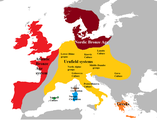



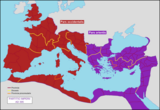

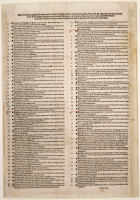

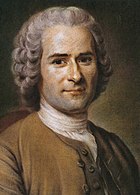
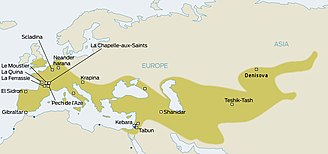
No comments:
Post a Comment